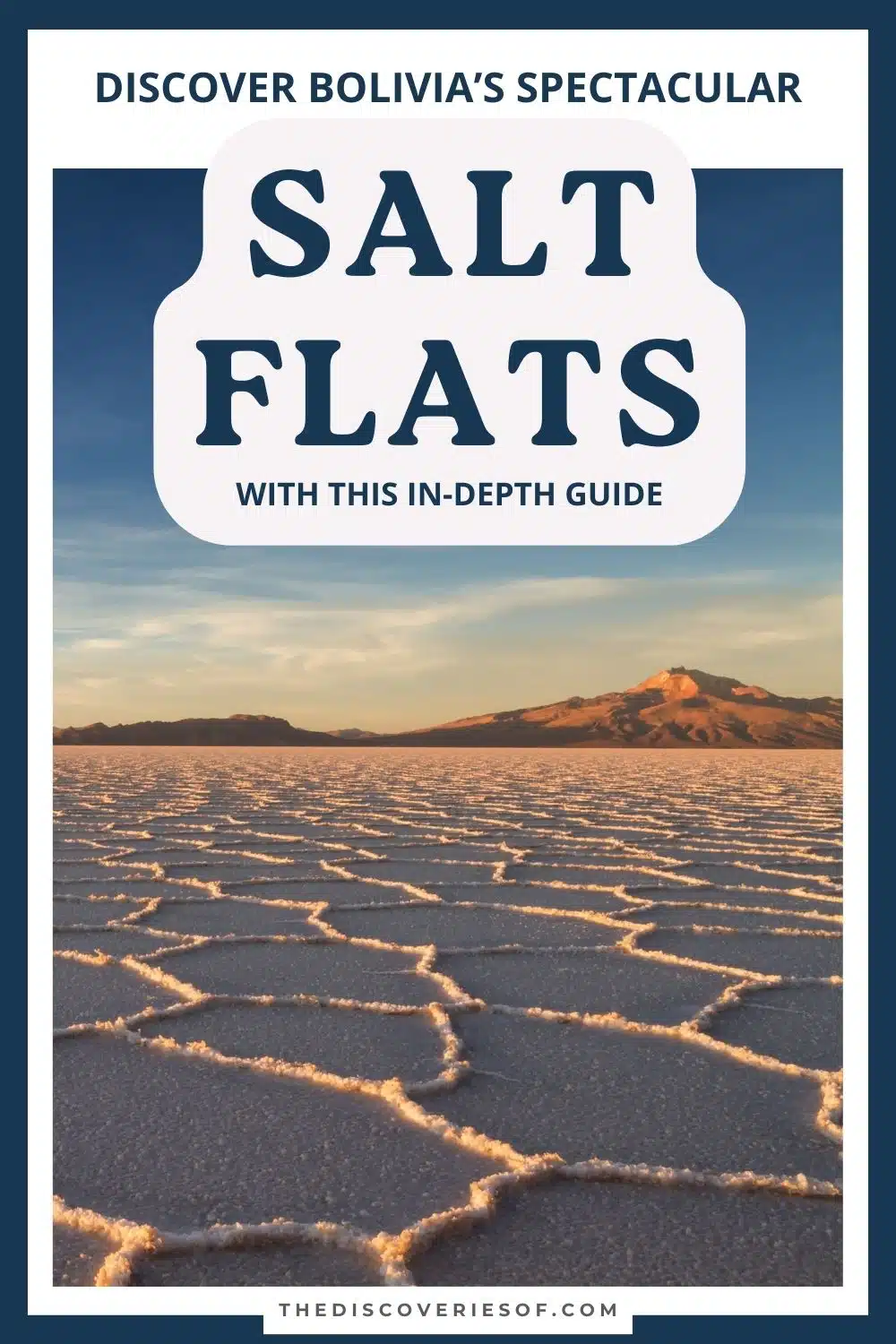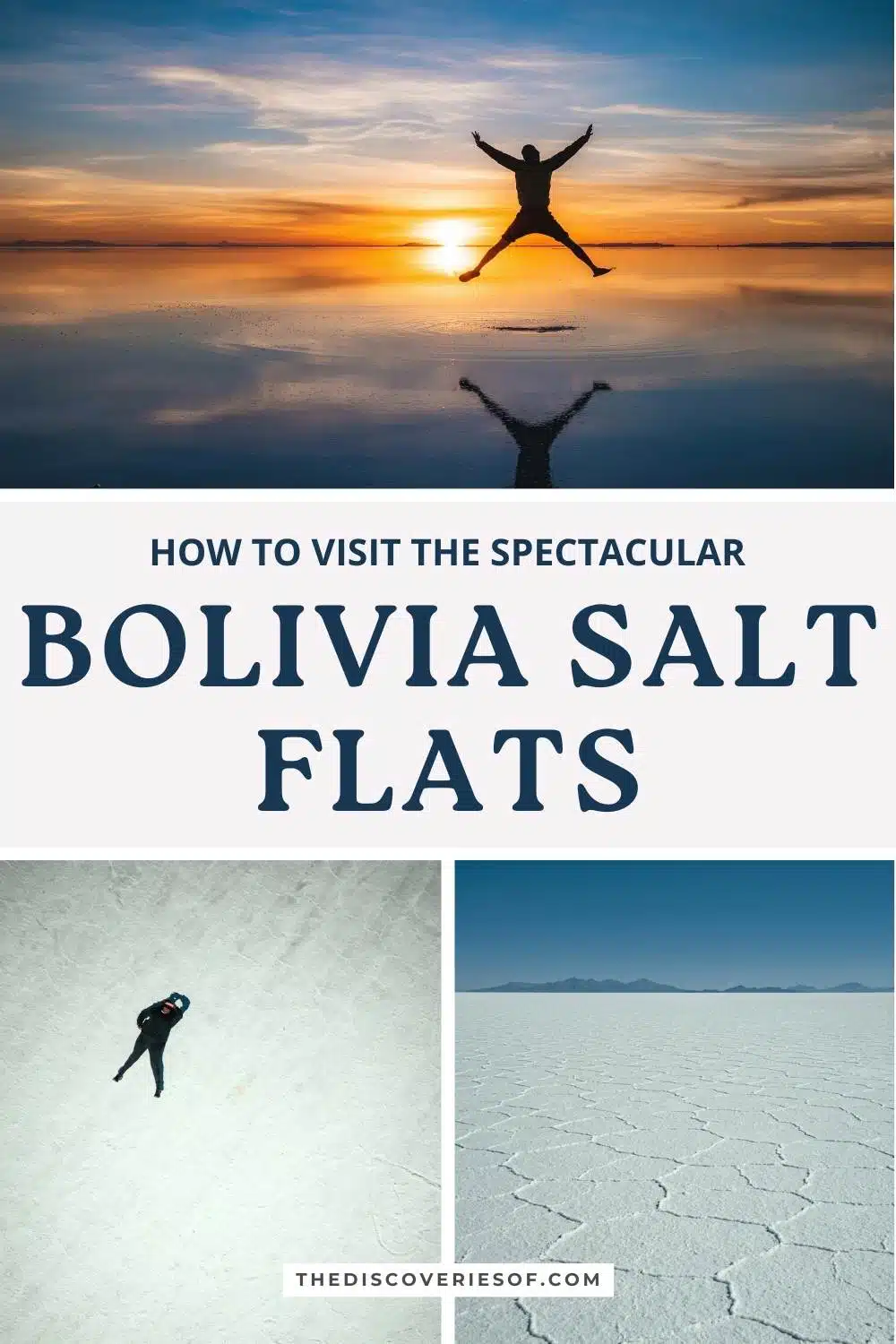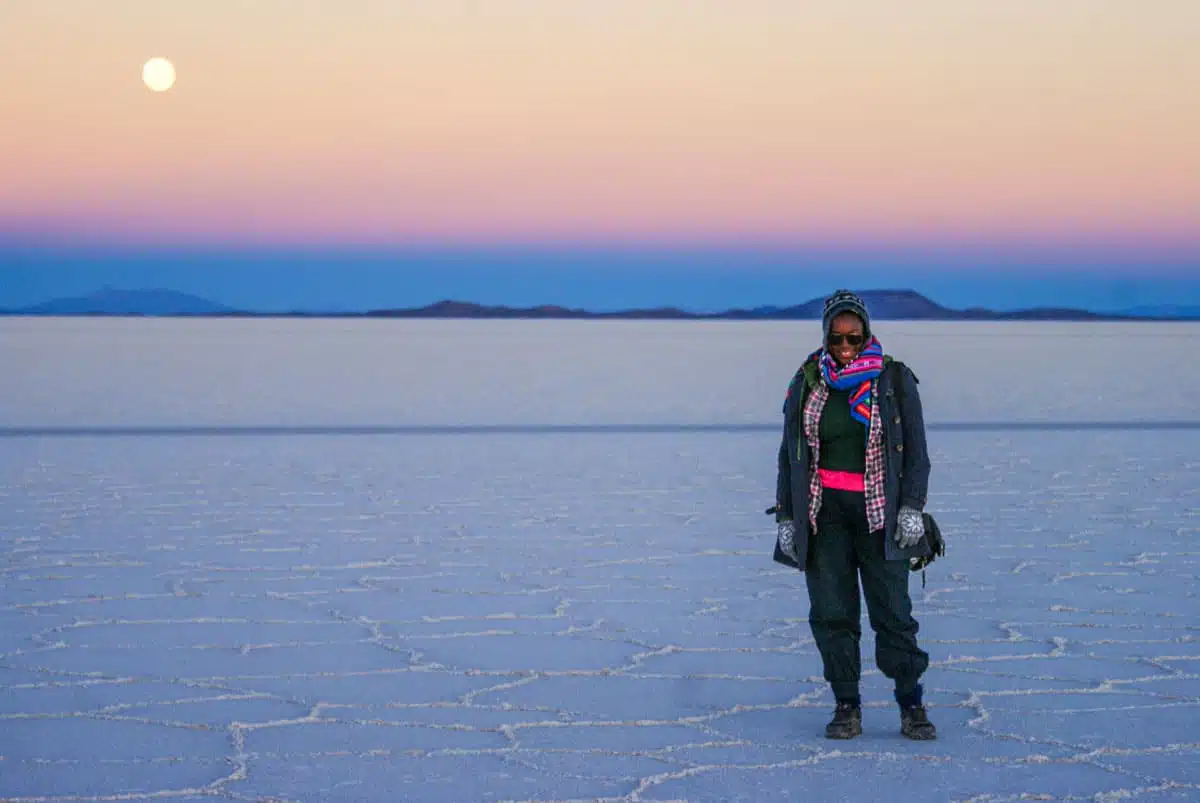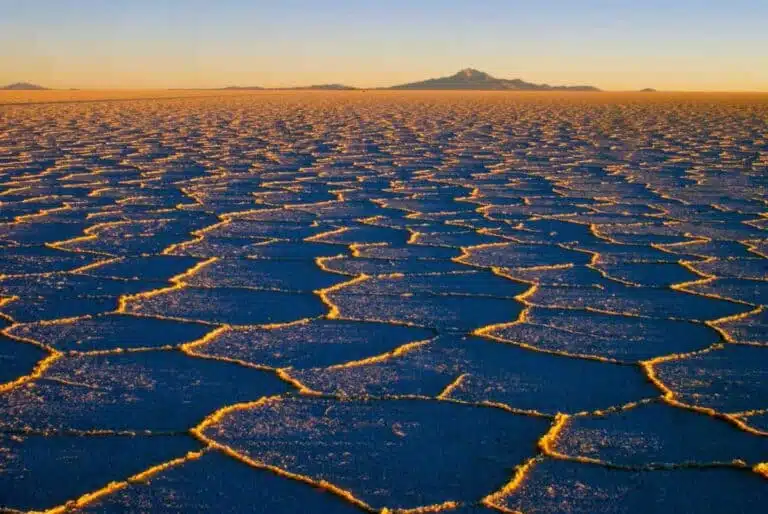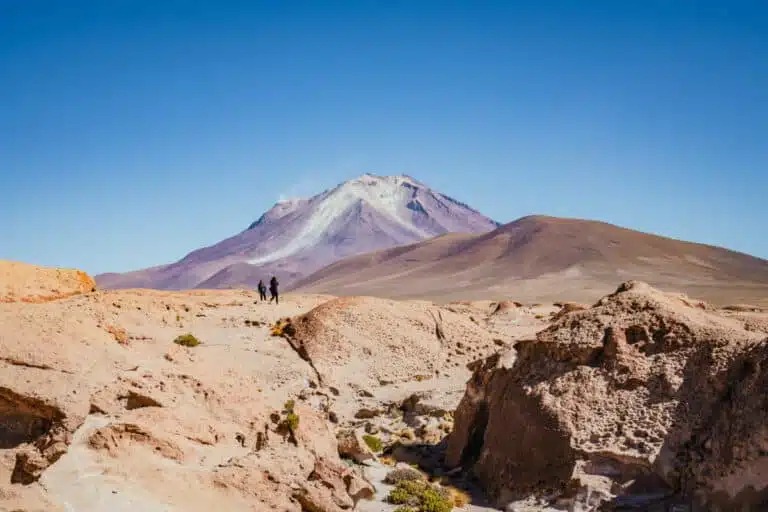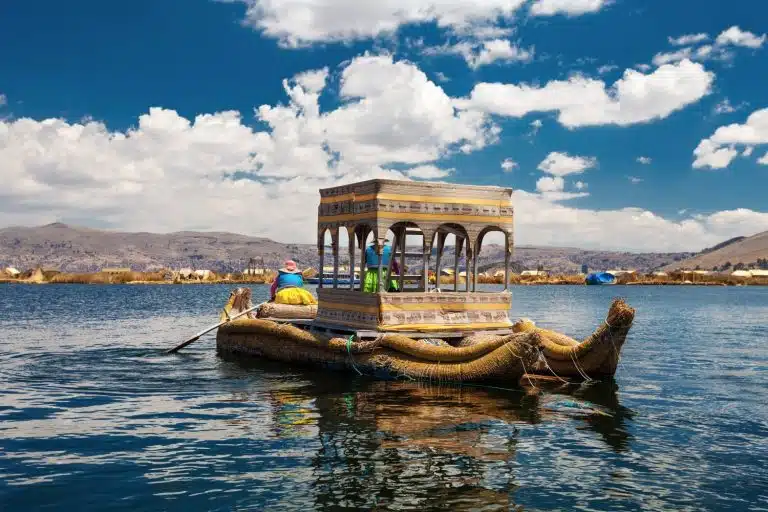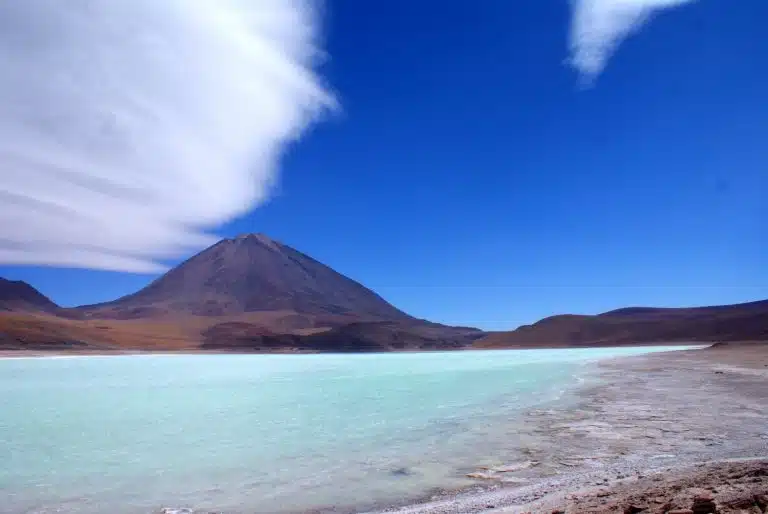Tessellations of crusted white glinting in the sun as far as the eye can see – it’s little wonder that the Salar de Uyuni – or the Bolivia Salt Flats – are one of South America’s bucket list spots. Plan your trip with this complete guide.
Bolivia’s Uyuni salt flats are one of the most photogenic places in the world. With over 10,582 square kilometres (4,086 square miles) of snowy white hexagonal patterns and clear blue skies, it doesn’t get much more gorgeous than this.
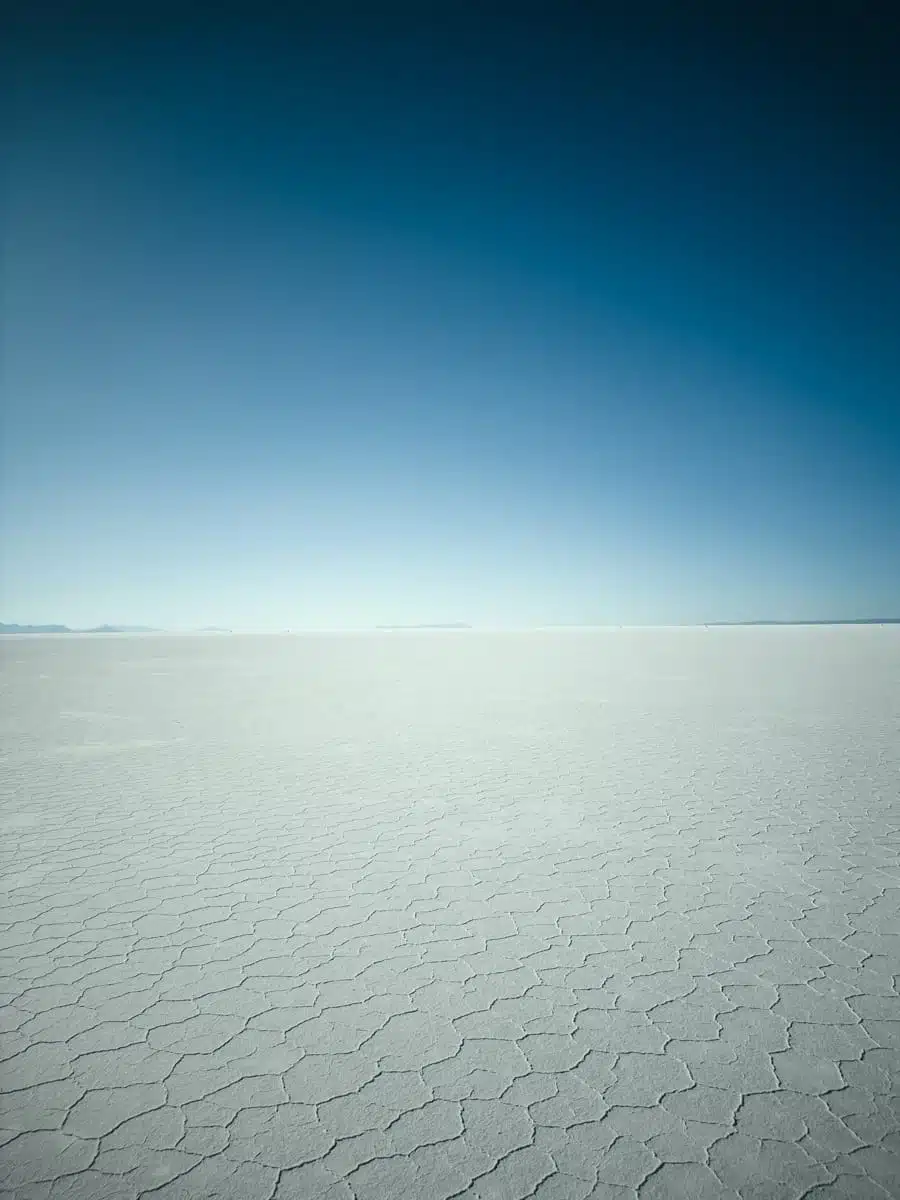
The first time I visited the salt flats in 2009, I had no idea of what to expect. We’d trucked on a four-day trip from Tupiza (there’ll be more details on that later), waking up in what felt like the middle of the night to pile into the 4×4, before stopping in the pitch black.
Within moments, the sun’s first rays shot over the horizon, gradually lighting the landscape in its path – we were in the middle of the salt flats with no one else in sight. Not going to lie, it was straight up one of my favourite travel moments and one I hope you get to experience for yourself.
Of course, in the age of Instagram and TikTok, the chance of you never having seen a picture of the salt flats is relatively slim – but you can still capture that wonder if you plan your trip right – and that’s exactly what this guide is going to help you do.
We’re going to cover why you should visit, what to see where you do, a brief jaunt through the history of this fascinating spot and exactly (and I mean exactly) what you need to know to plan your trip.
Ready to embark on a journey to the largest salt flats anywhere in the world? I thought so.
Why Visit?
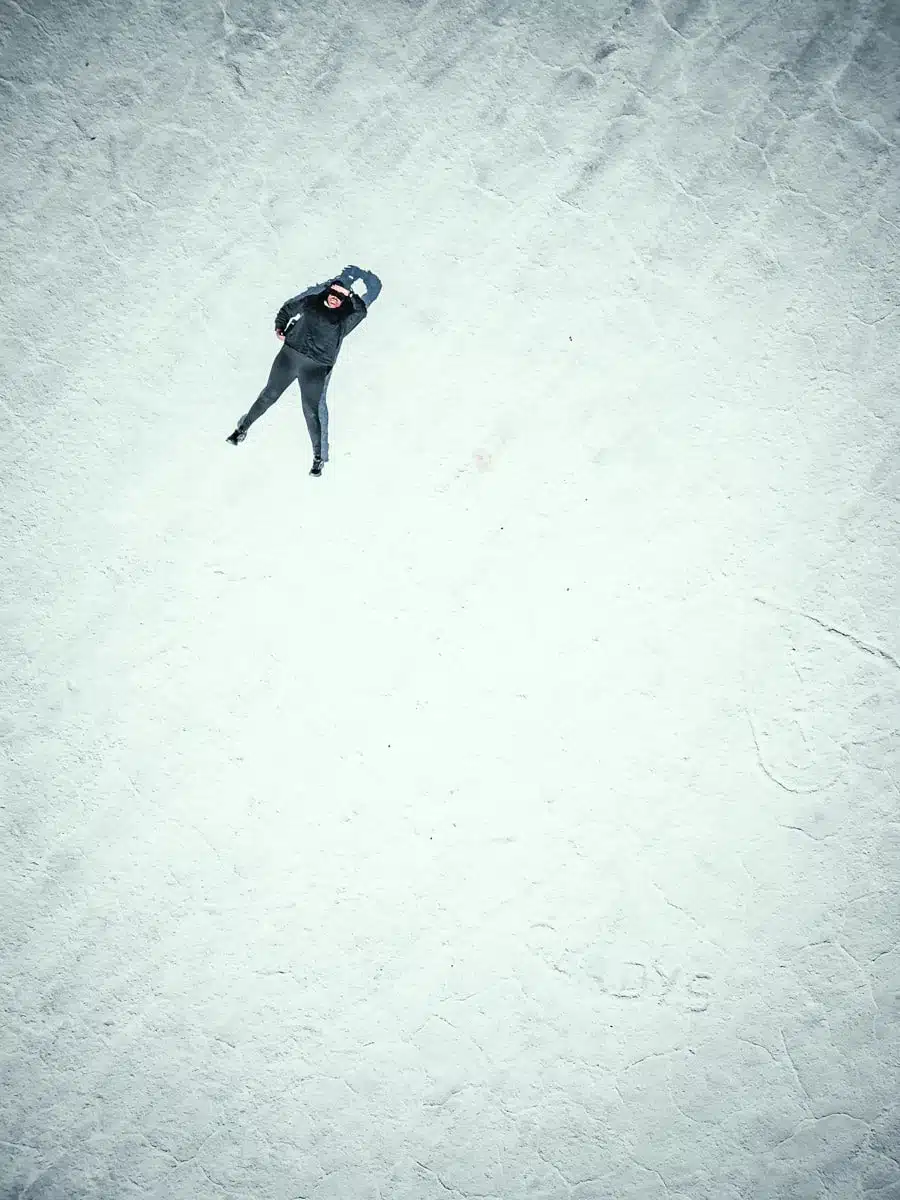
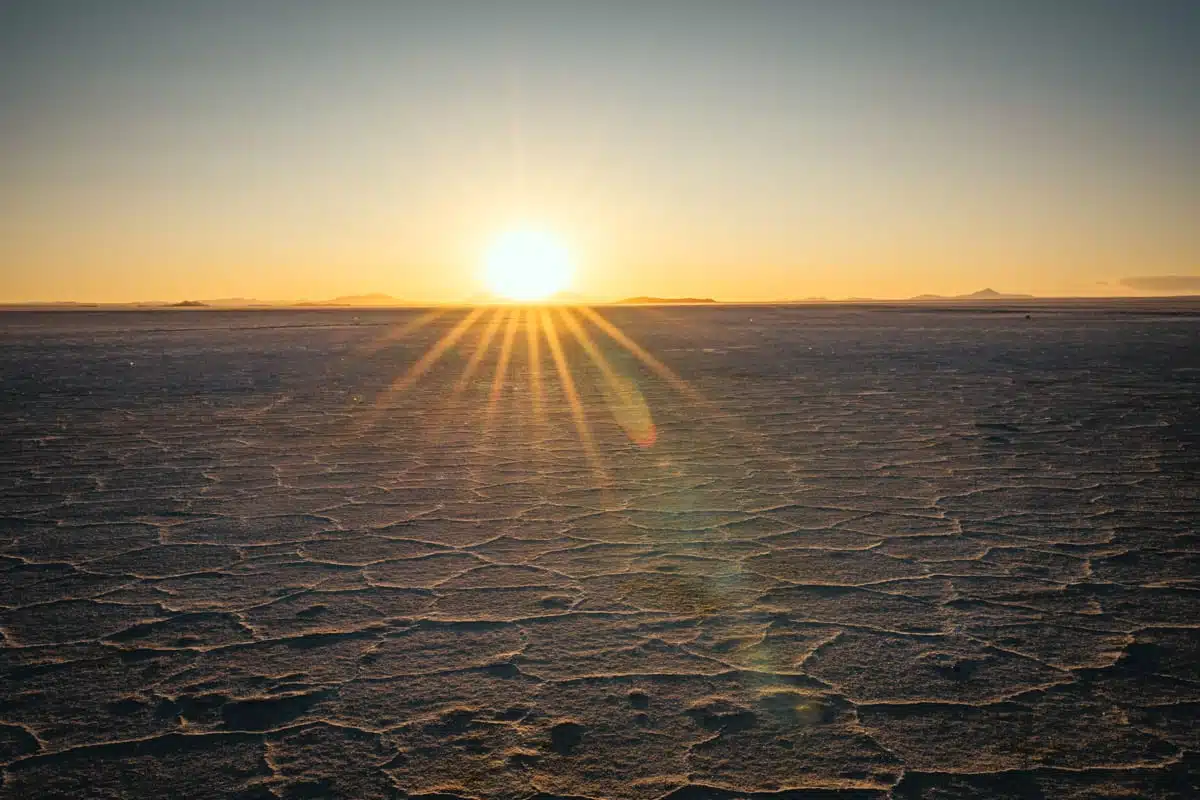
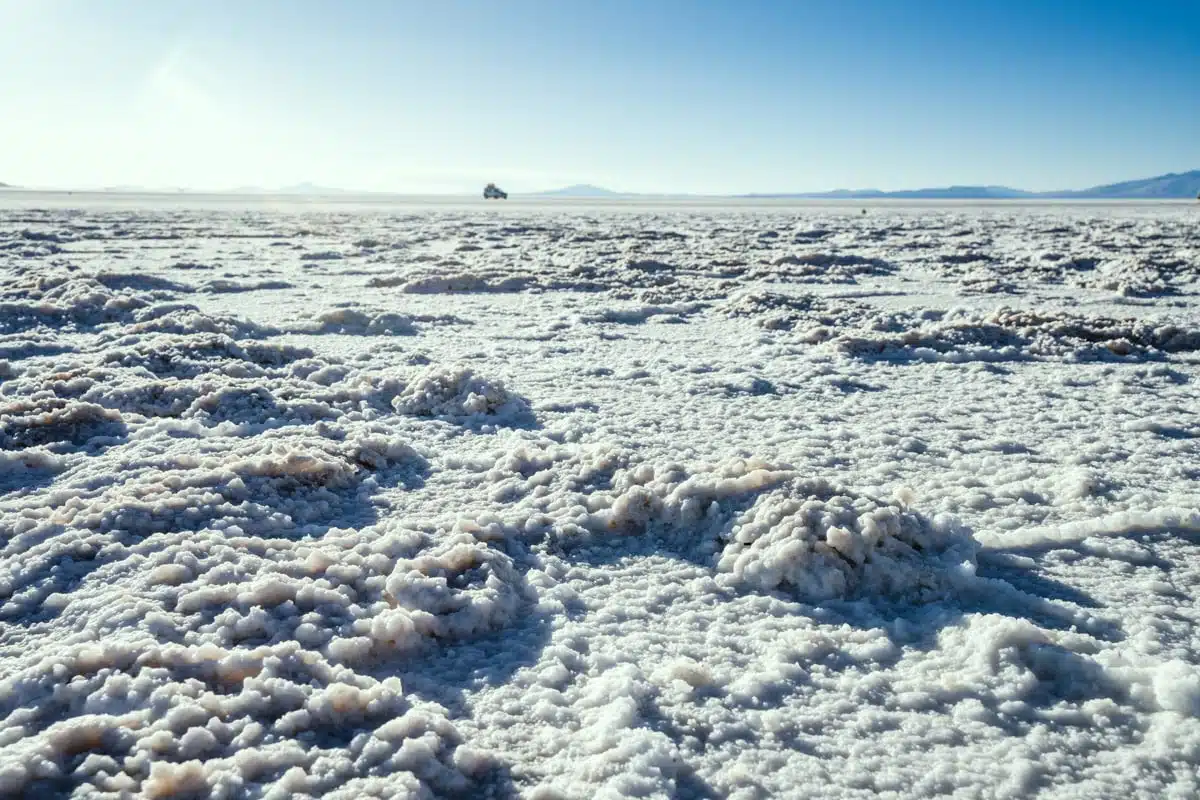
If you’ve ever had even a slight urge to check out the Uyuni salt flats, I urge you to go. There’s no other place in the world where you’ll find this kind of scenery at this magnitude.
The crystalline salt flats form perfect patterns that weave their way across endless stretches of the desert landscape. During the rainy season (January to April), the landscape disappears underwater to create the famous Bolivia salt flat mirror effect you may have seen on the ‘Gram.
And there’s actually a lot more to see here, including islands of cacti, three species of flamingos, “salt hotels” and abandoned trains you can explore.
If you have a knack for adventure and a passport, visiting Salar de Uyuni should be at the top of your travel list. Here’s a sneak peek at some of the fun!
Things to do at the Salar de Uyuni
Think a trip to the Salar de Uyuni is only about seeing the flats themselves? Think again. There is a lot to see here, whether you choose a guided tour or want to explore the hexagonal patterns across the stark white desert all on your own. Here are a few of the must-see attractions.
Climb to the Top of Fish Island
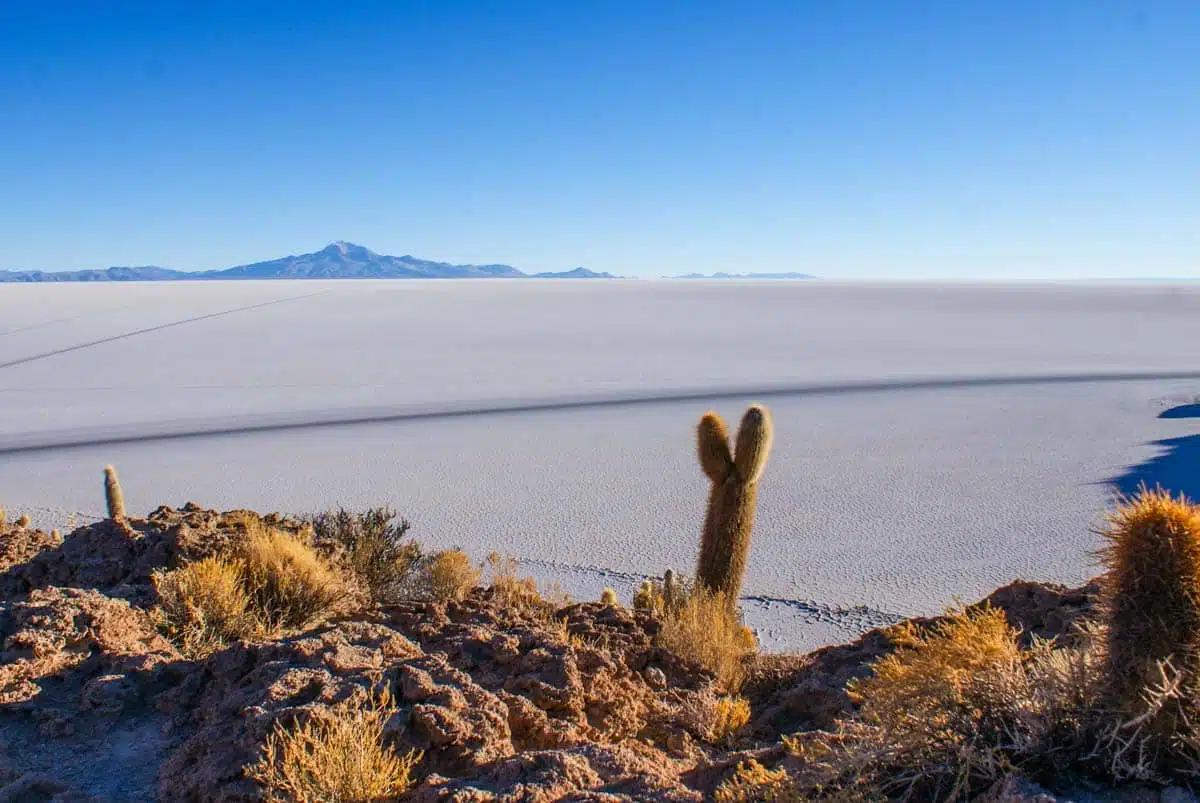
There are lots of cacti-laden islands that pop up in the vast desert landscape of the salt flats. Fish Island is one of my favourites.
You’ll see gigantic cacti (I’m talking 10 metres high), which is really an unexpected botanical wonder compared to the mostly desolate setting.
Stretch your imagination and look closely enough from above, and you might see why the island got its name. Supposedly it looks a lot like a fish (I’m still a bit sceptical, myself).
Nonetheless, it’s a beautiful change of scenery, with the Trichocereus (cereus) cactus and viscacha (a rather adorable rodent) offering a rare brush with nature in the otherwise rather barren plains.
Top Tip
You can also visit Incahuasi island – another cactus-covered island in the middle of the salt flats – do the 15-minute hike to the top for stunning views of the salar.
Play With Perspective and Take Some Weird Photos & Videos
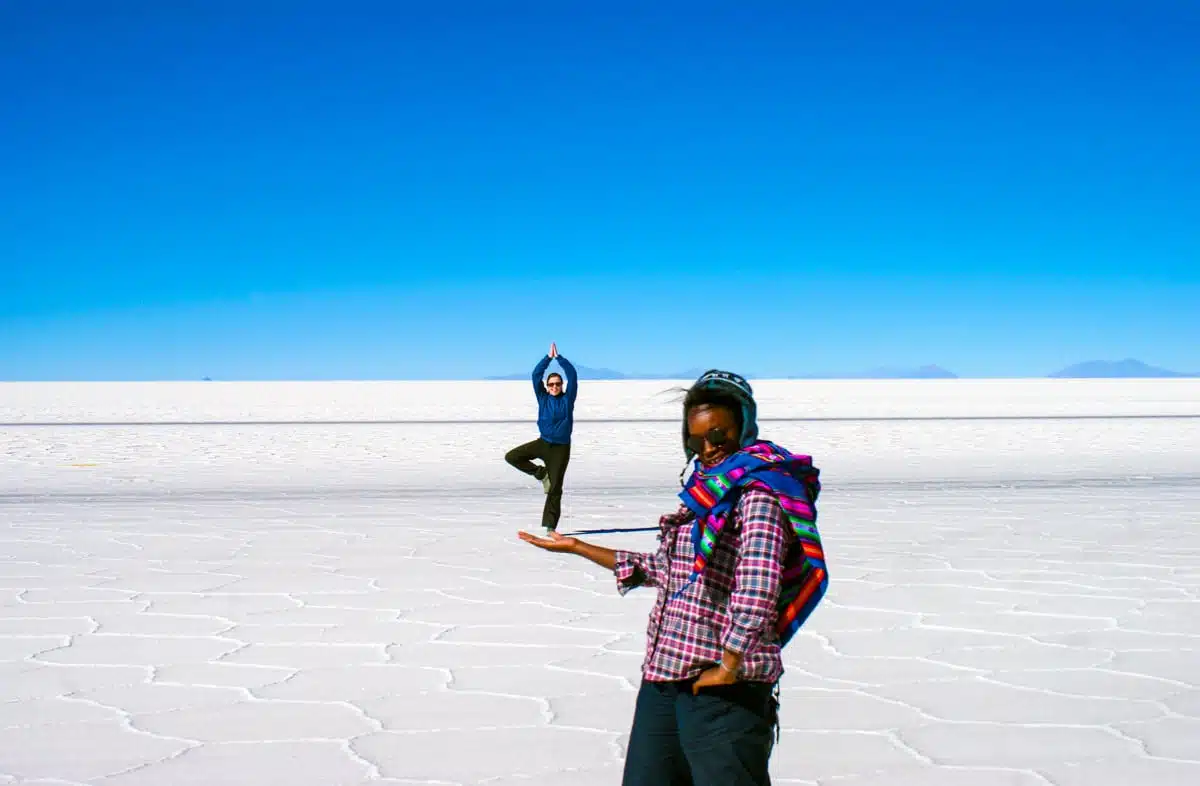
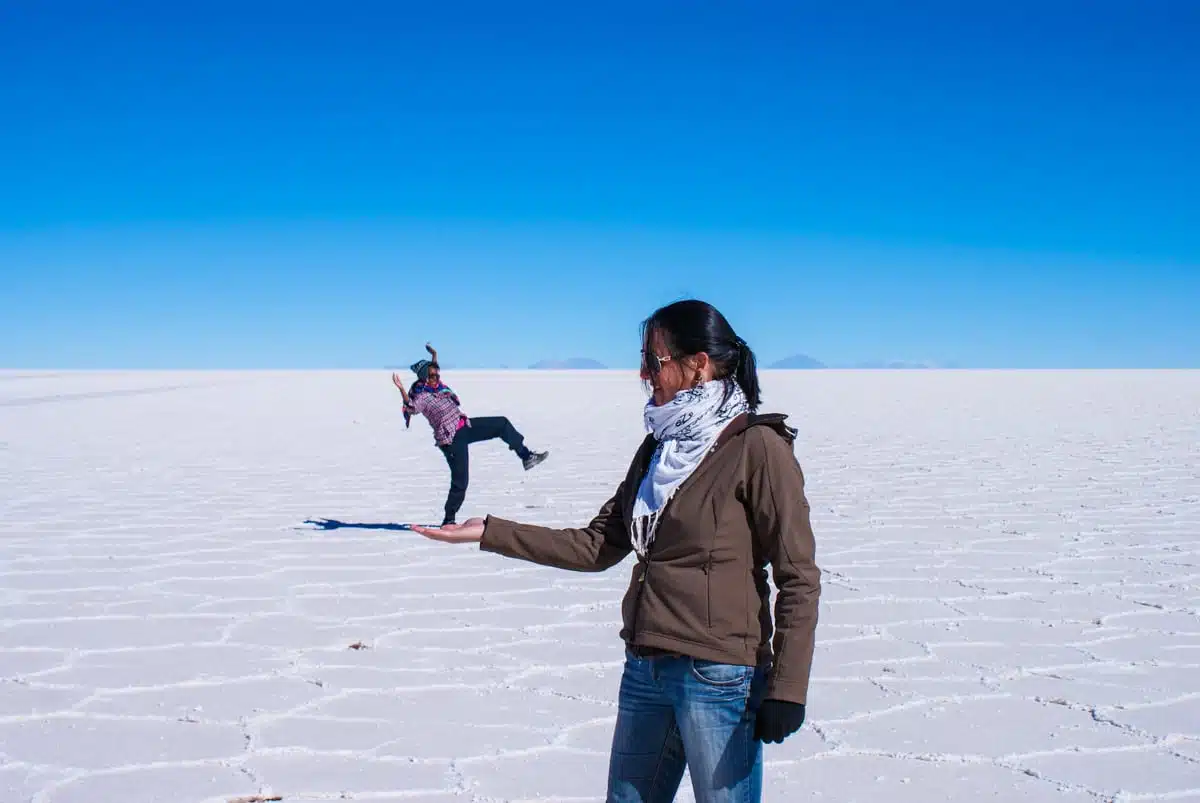
Look, I won’t lie – cheesy as the photos may look, it’s so fun taking pictures that mess around with perspective while you’re on the salt flats! There are very few places where you can find somewhere so large and flat, so it’s the perfect spot to take all manner of weird and wonderful pictures.
Top Tip
Your guide will probably bring some props, but if there’s anything specific you want to do, make sure you bring any necessary props with you.
Visit The Train Cemetery
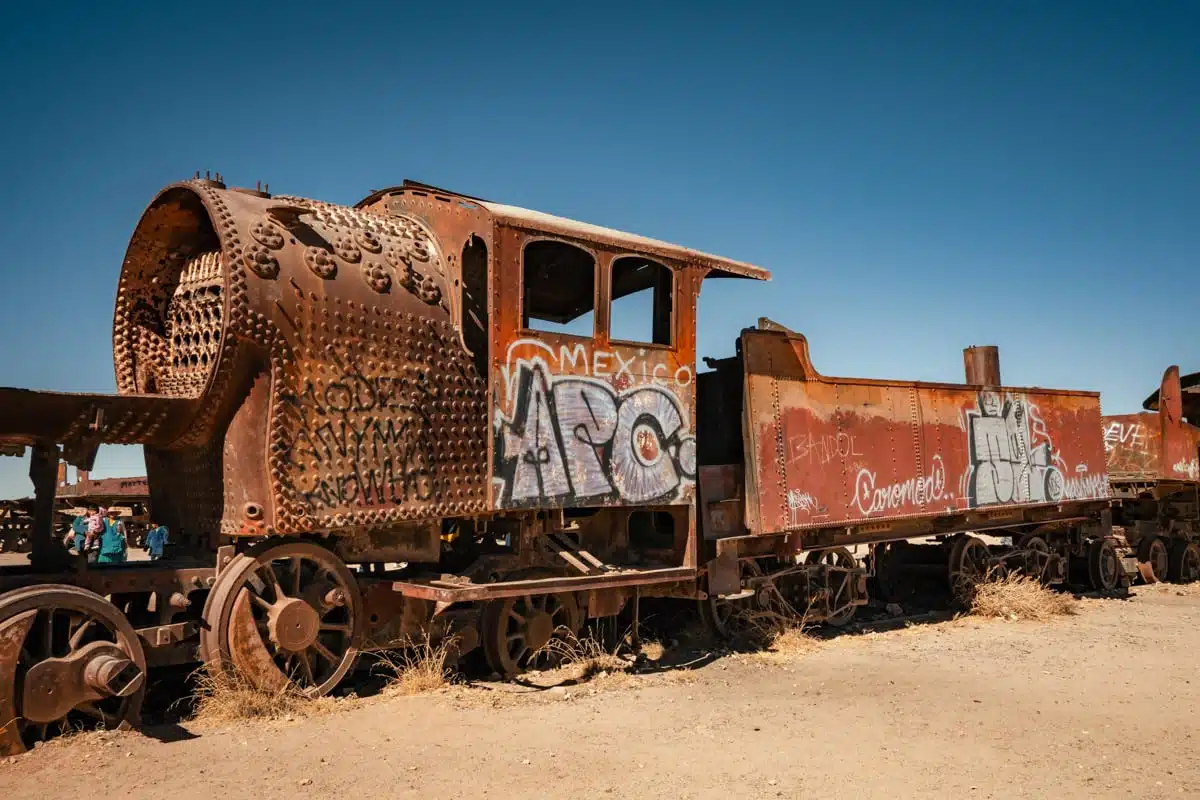
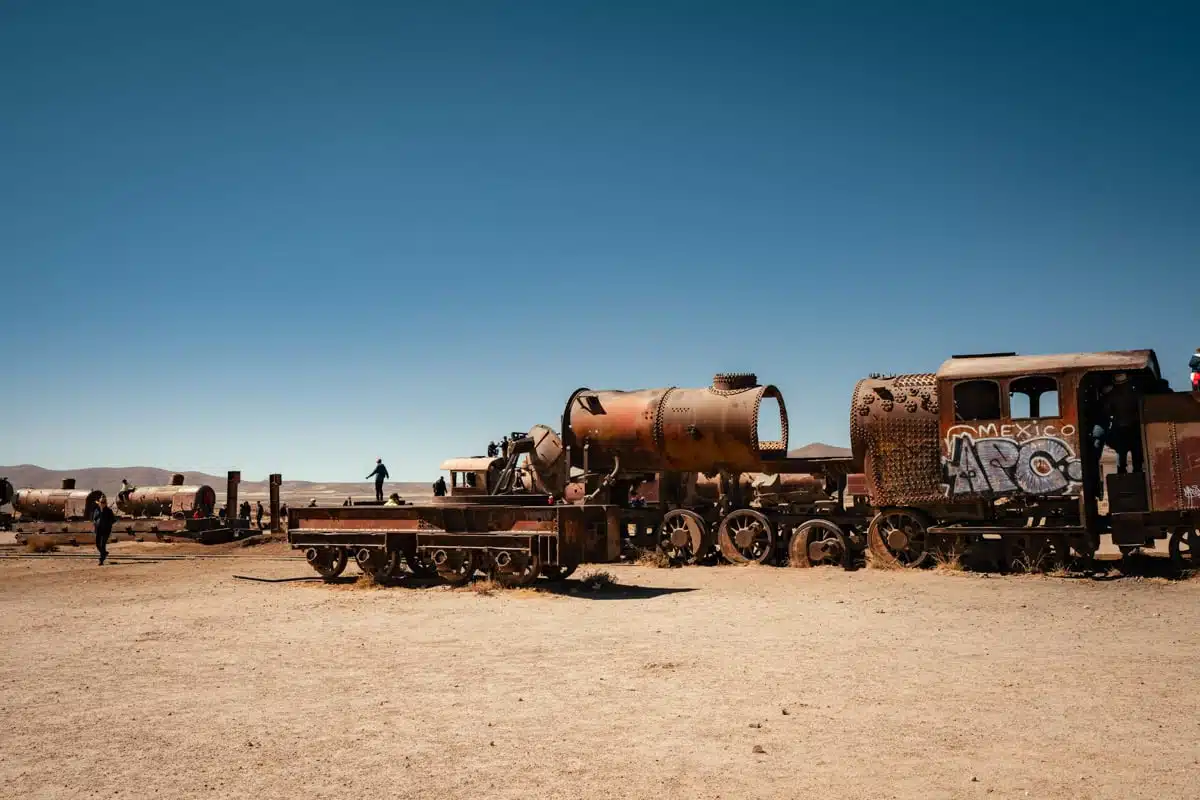
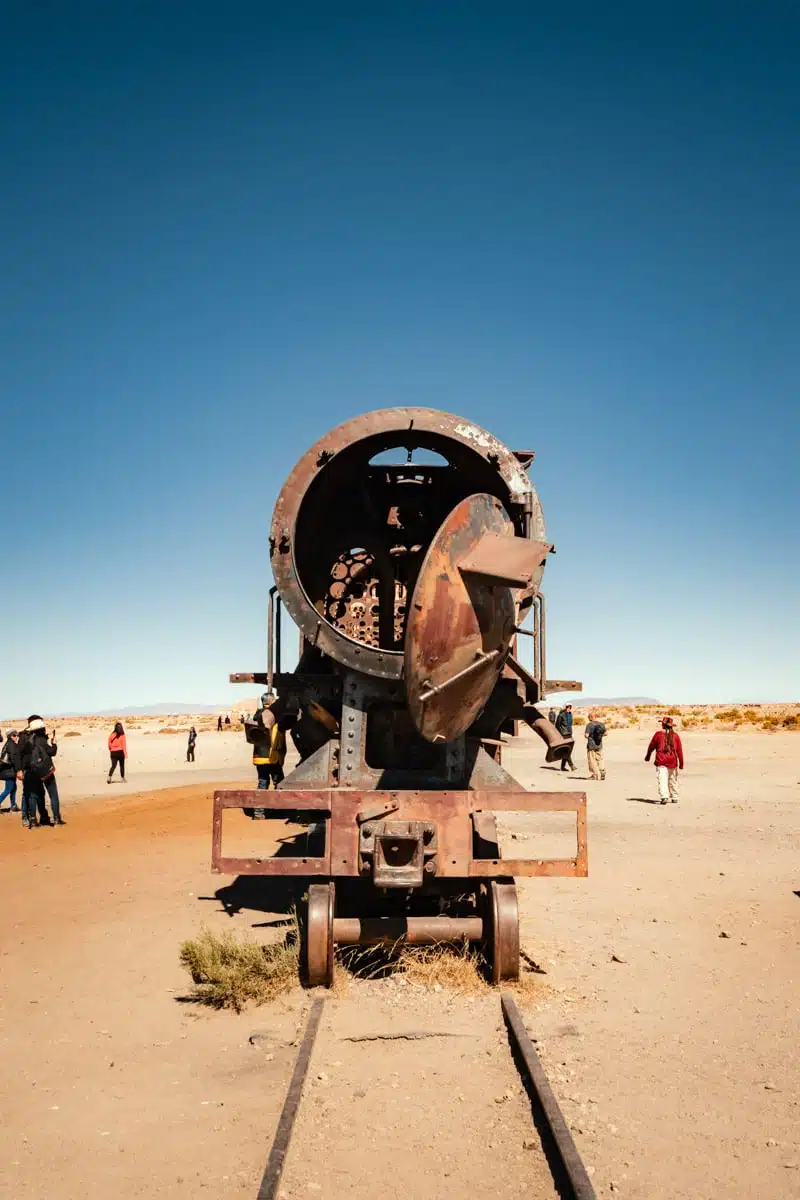
One of the stranger attractions near Salar de Uyuni is the train cemetery just outside of the city of Uyuni.
Say what? Yes, a cemetery of trains. Back in the 19th and 20th centuries, this region was a thriving mining area, and trains from the UK transported minerals from Uyuni to other regions. Flash forward a few decades, and the industry dried up, trains sat out in the Bolivian salt flat desert, and they formed what’s now the Train Cemetery.
Top Tip
It’s a cool place to spend an hour or so with your camera and catch some shots of the abandoned trains and the desert skies.
Check Out the Colourful Flags from the Dakar Rally
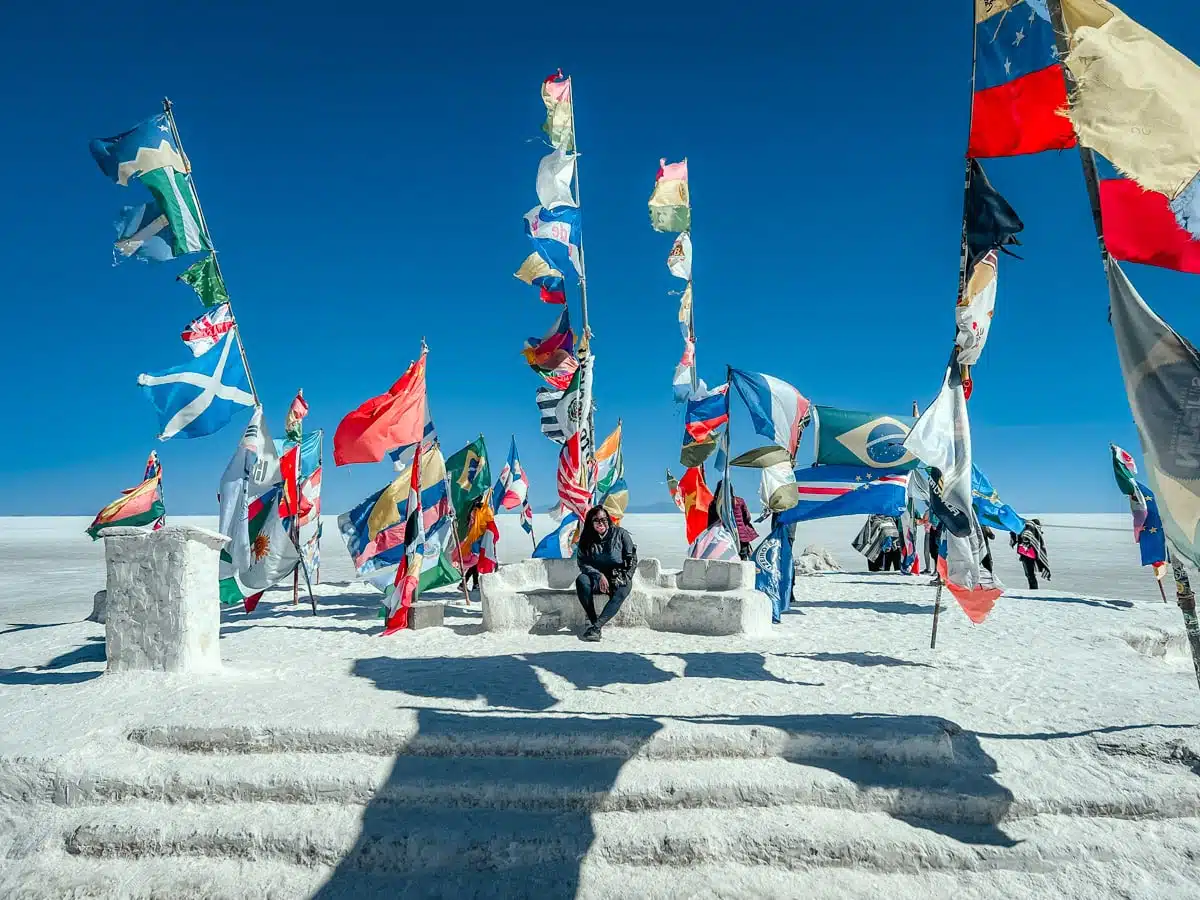
Ever heard of the Dakar Rally? You know, the gruelling race that involves taking your UTV, quad, motorbike, or truck through some of the world’s most inhospitable climates Mad Max style – well, it took place in the Bolivia Salt Flats a few years back.
People participated from all over the world, and you can still see their national flags proudly standing on a salt block against the whitewashed ground and bright blue sky.
It’s worth a stop for some great photos and a glimpse into the international event.
Explore the Old Playa Blanca Salt Hotel
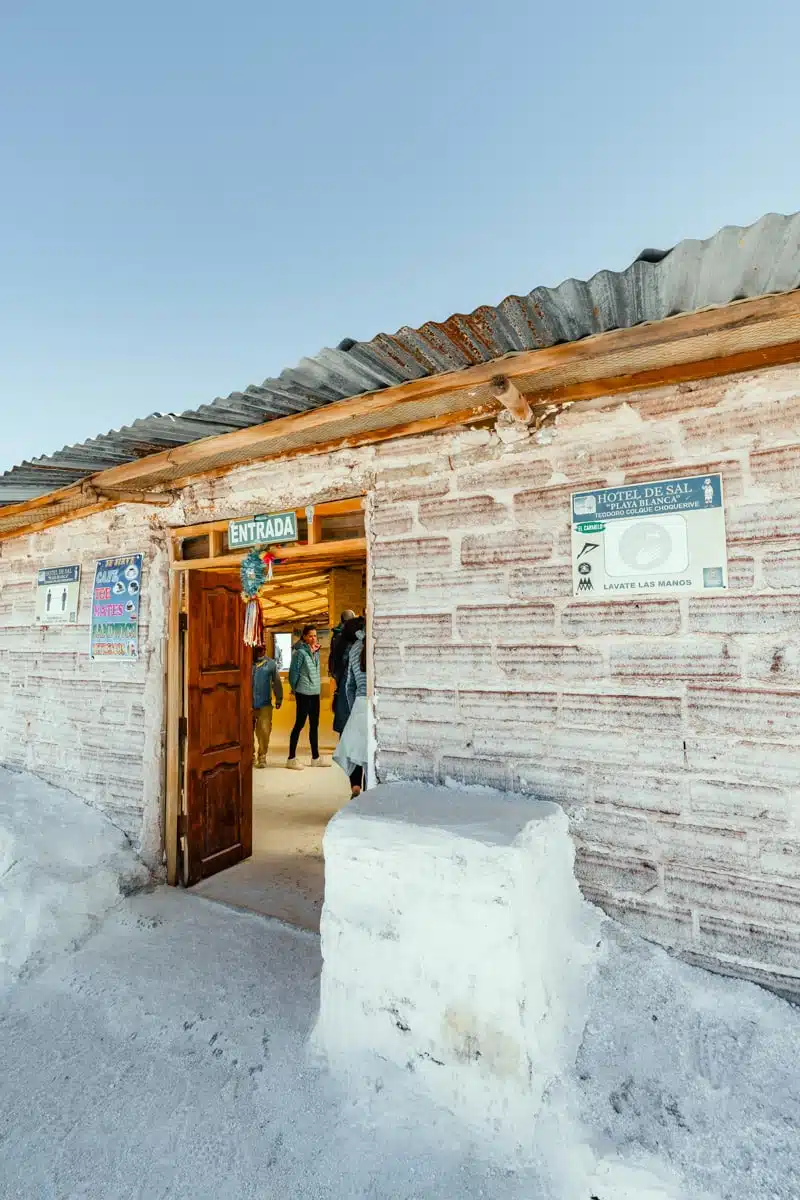
You’ll see a lot of “salt hotels” when you’re exploring Bolivia salt flats luxury hotels.
There are quite a few worth visiting, but Playa Blanca stands out because the hotel sitting smack dab in the middle of the flats is no longer operating – meaning it’s a great place to use as a shelter from the sun and see a salt hotel up close too.
It’s next to the Dakar Rally flags and has a gift shop and restrooms, making it a nice place to check out when you need a break from the blistering heat in the middle of the day.
Pop into the Salt Museum at Colchani
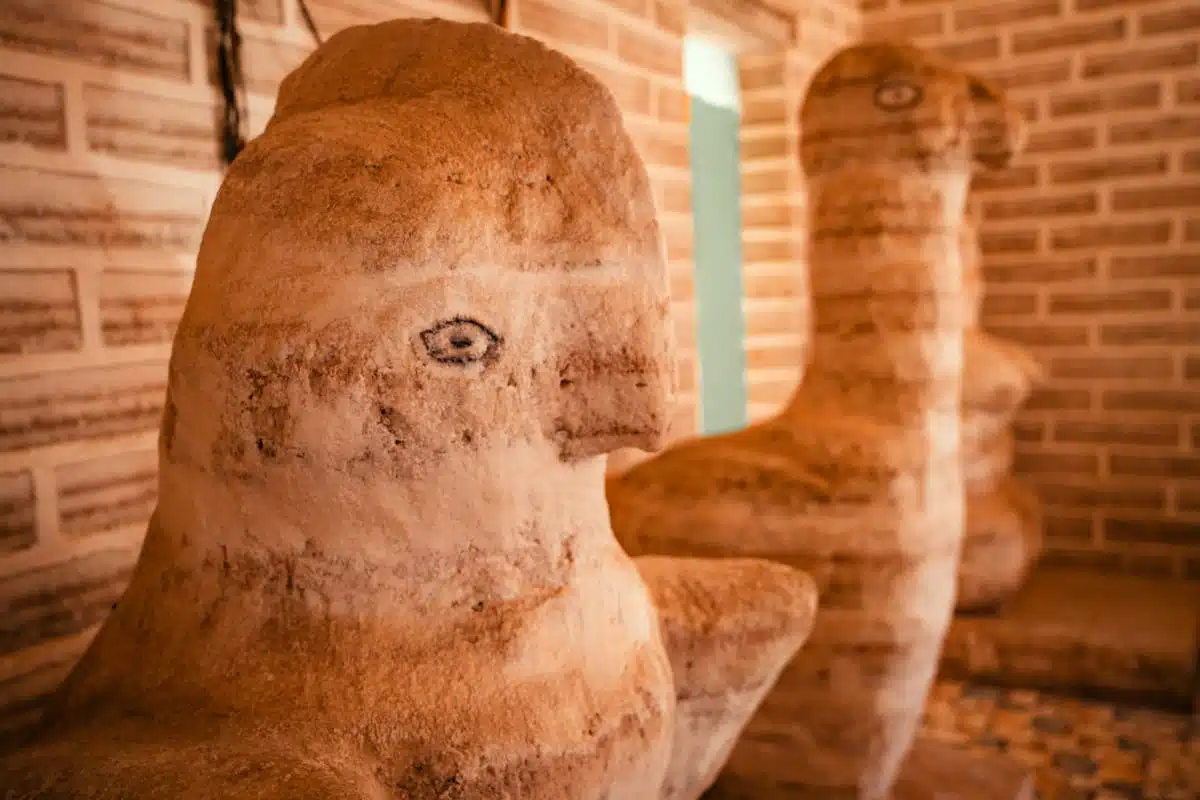
Although the small town of Colchani might not look like it has a lot going on other than its (pretty cool) market, it is worth popping into on your way to or from the flats if you can.
Why? There’s a cool museum where you can learn more about salt processing and mining, and the marketplace actually has some cool handmade souvenirs. The Museo de la Llama y la Sal gives you a chance to see a building and sculptures made from salt, and learn more about how it’s processed by locals.
Continue the Journey to Laguna Colorada
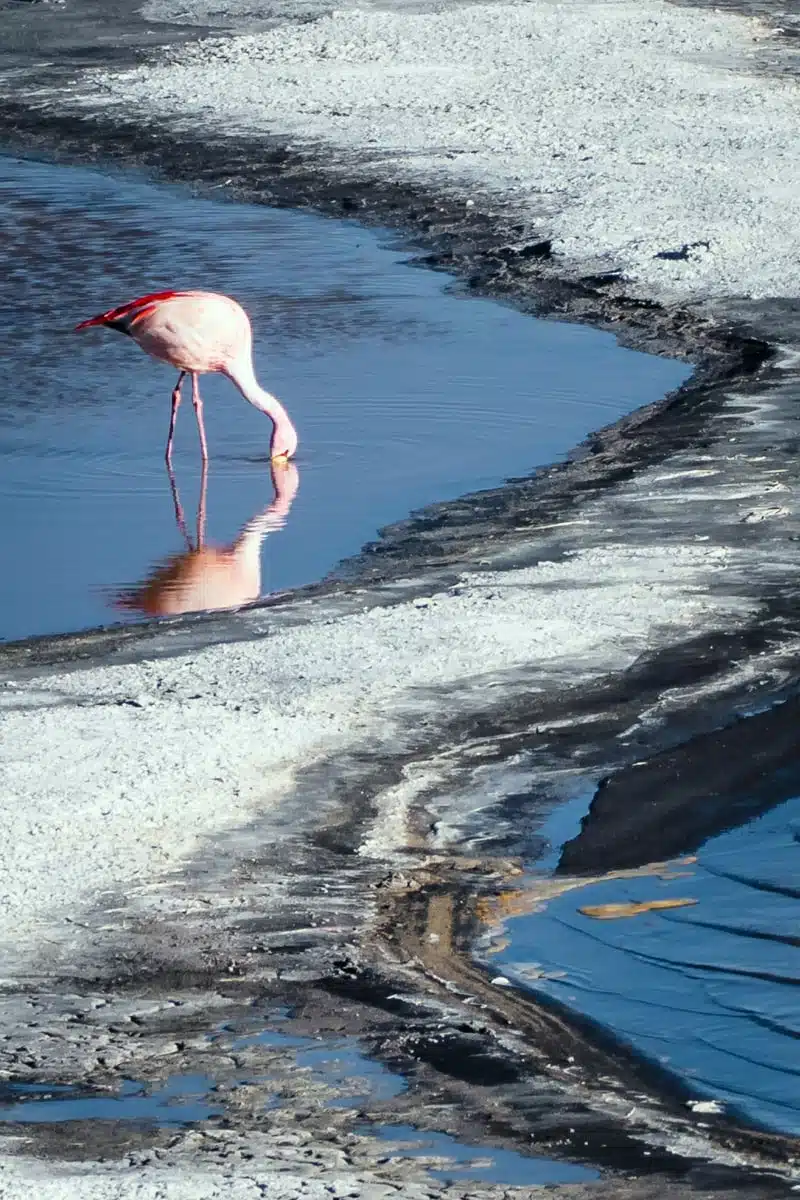
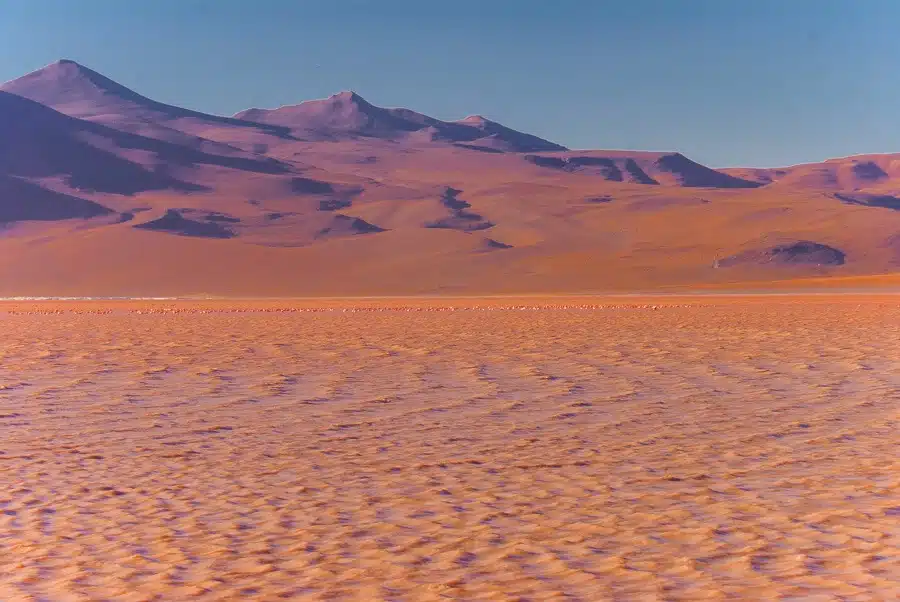
Have you ever seen a blood-red laguna before? Well, you’re about to now. Laguna Colorada, isn’t in Salar de Uyuni, but it’s close enough that you’ll definitely want to add it to your trip.
Why? It’s one of the best places to see flamingos in the region. Go in the summertime, and you’ll see literal thousands of them feasting on algae in the bright red lake in Southern Bolivia.
The lake itself is a photographer’s dream – the contrast of the crimson waters and bright white borax is a spectacle you have to see yourself to believe.
So Now You Know What to See, Here’s a Little More Info About the Salt Flats Too
The Formation of the Salt Flats
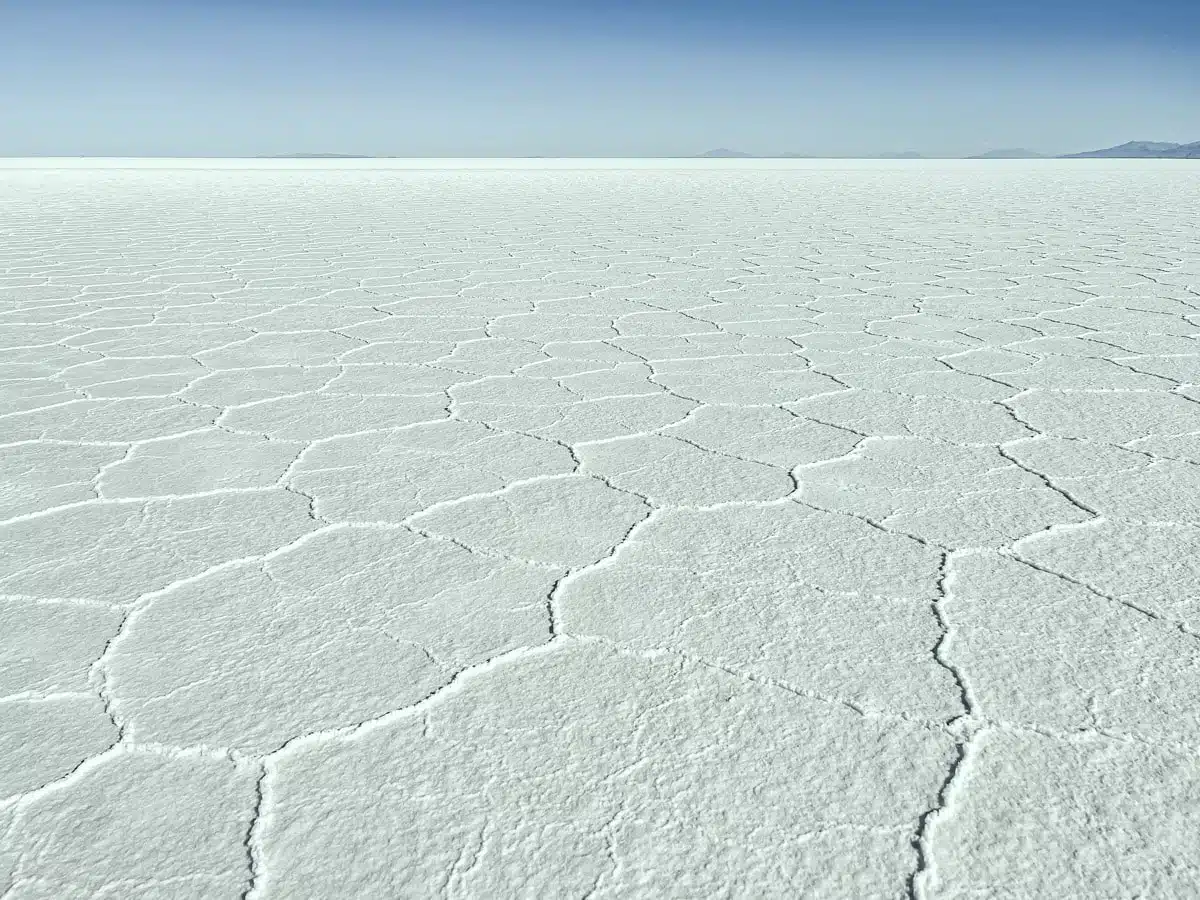
If you’re looking at the Uyuni Salt Flat and think it looks like something from a long lost time – you’re not wrong. The largest salt flat on the planet dates back to prehistoric times – when it was a massive lake.
It turned into a snow-white desert landscape somewhere around 40,000 years ago when Lake Minchin lost its water as shifting tectonic plates changed the landscape forever.
Now, it’s over 10,000 km of desert-like landscape, defined by the 10 billion tons of salt resting on the top layer.
Location
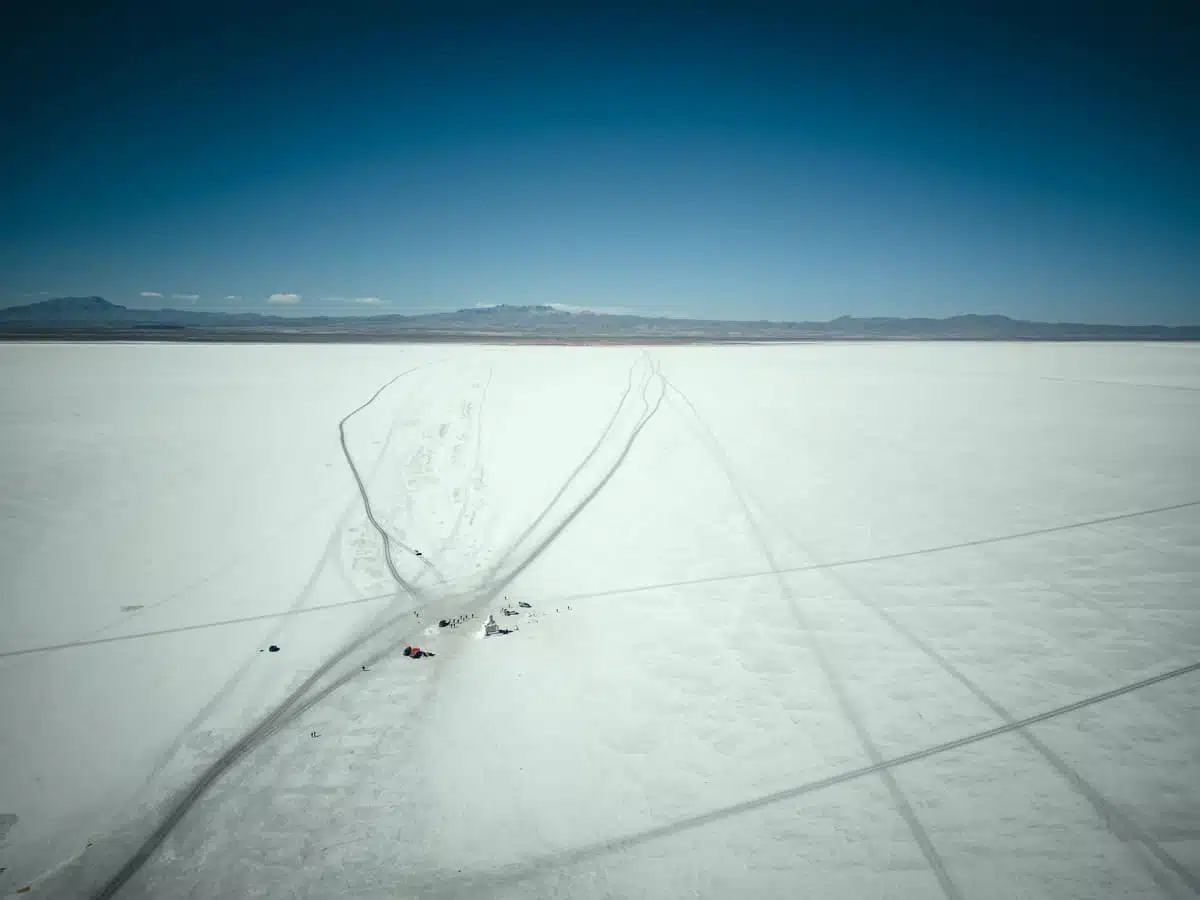
The Uyuni Salt Flats are a lot higher up than you may think. Situated at an elevation of 3,656 metres, the Bolivia Salt Flats are perched high in Southwest Bolivia near to the border with Chile.
Uyuni is the nearest big city and is located on the eastern side of the flats. From Uyuni you make your way to the Altiplano, which is a plateau featuring the Sol de Mañana Geysers, several stunning lagoons and the blood-red Laguna Colorada.
It’s a Mining Hotspot
The salt flat in Bolivia is the largest you can find anywhere in the world, so there must be more than meets the eye, right?
Well, as I mentioned earlier – the former lake dried up thousands of years ago, leaving this IG-famous landscape that people travel worldwide to see.
But not only is it filled with the seemingly endless white salt, but it’s also rich in lithium – and accounts for around 50% of the world’s lithium reserves. Next time you see an EV on the road, it’s a safe bet that the battery is powered by lithium from Salar de Uyuni.
It’s Even Used By NASA
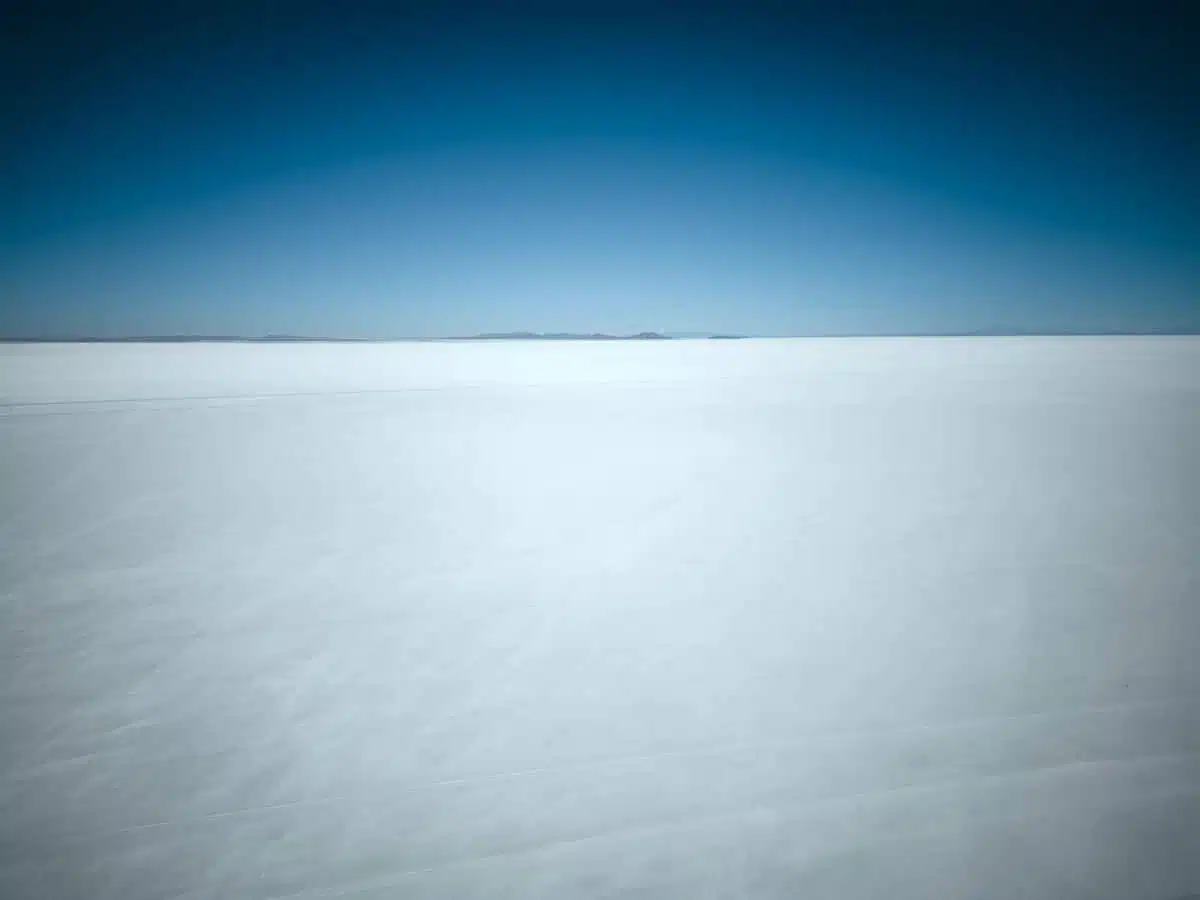
Ok, fun fact. NASA actually uses the salt flats to calibrate satellite orbits due to the large, flat surface area that the Bolivia salt flats lie on. You’ll know why when you see just how long, flat, and consistent the Salar de Uyuni landscape is.
Planning Your Visit to Salar de Uyuni
When to Visit
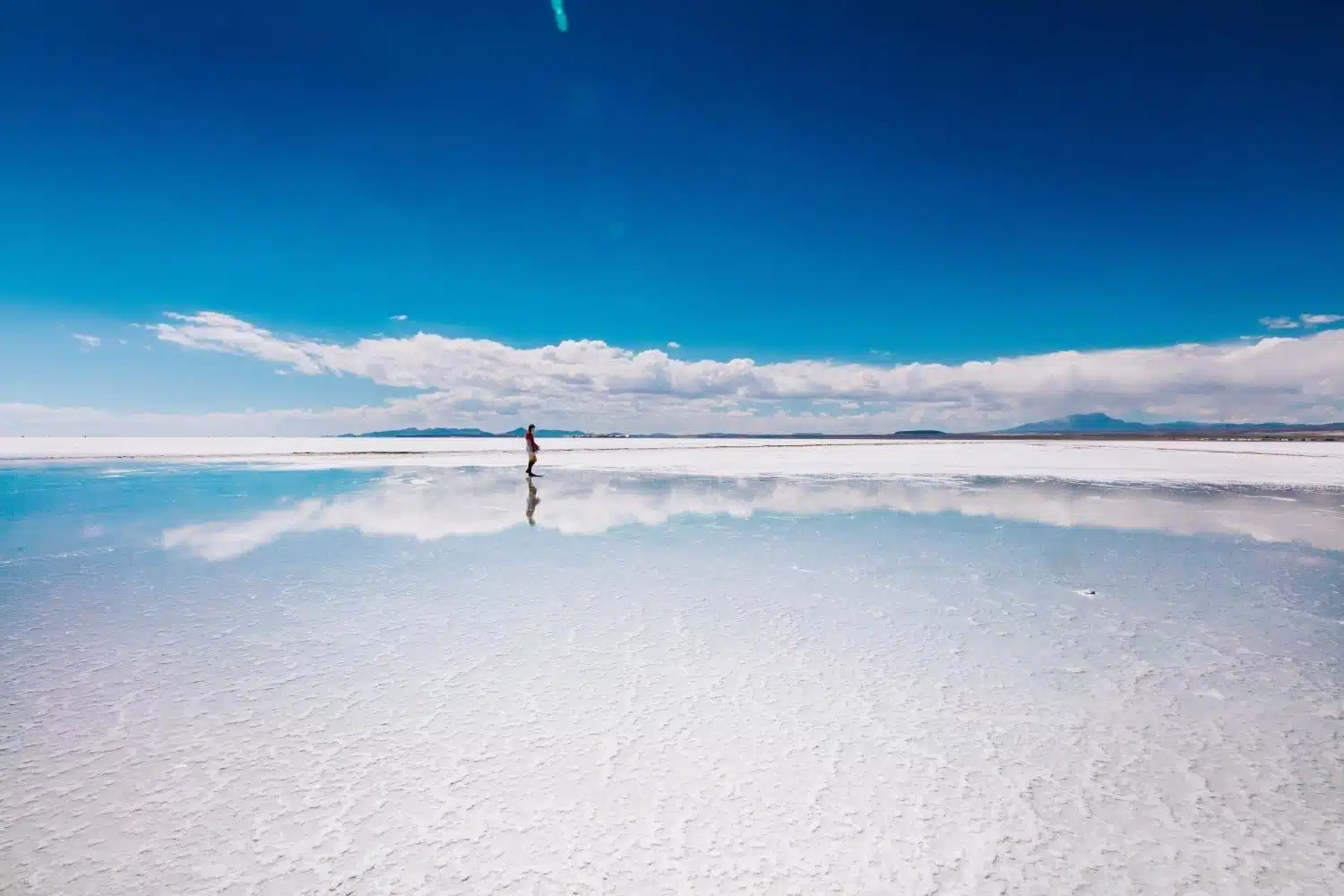
The rainy season lasts from November to February, making summer the best time to get the mirror-effect on the flats.Temperatures are usually relatively mild, often not getting much hotter than 70°F.
Wind and sun are factors much of the year, due to the high elevation and wide open flats.
Weather is much colder in the winter, with temperatures dipping below freezing, so be sure to pack for the weather if you visit from May to September.
Read Next
Seeing the Salar de Uyuni On a Tour
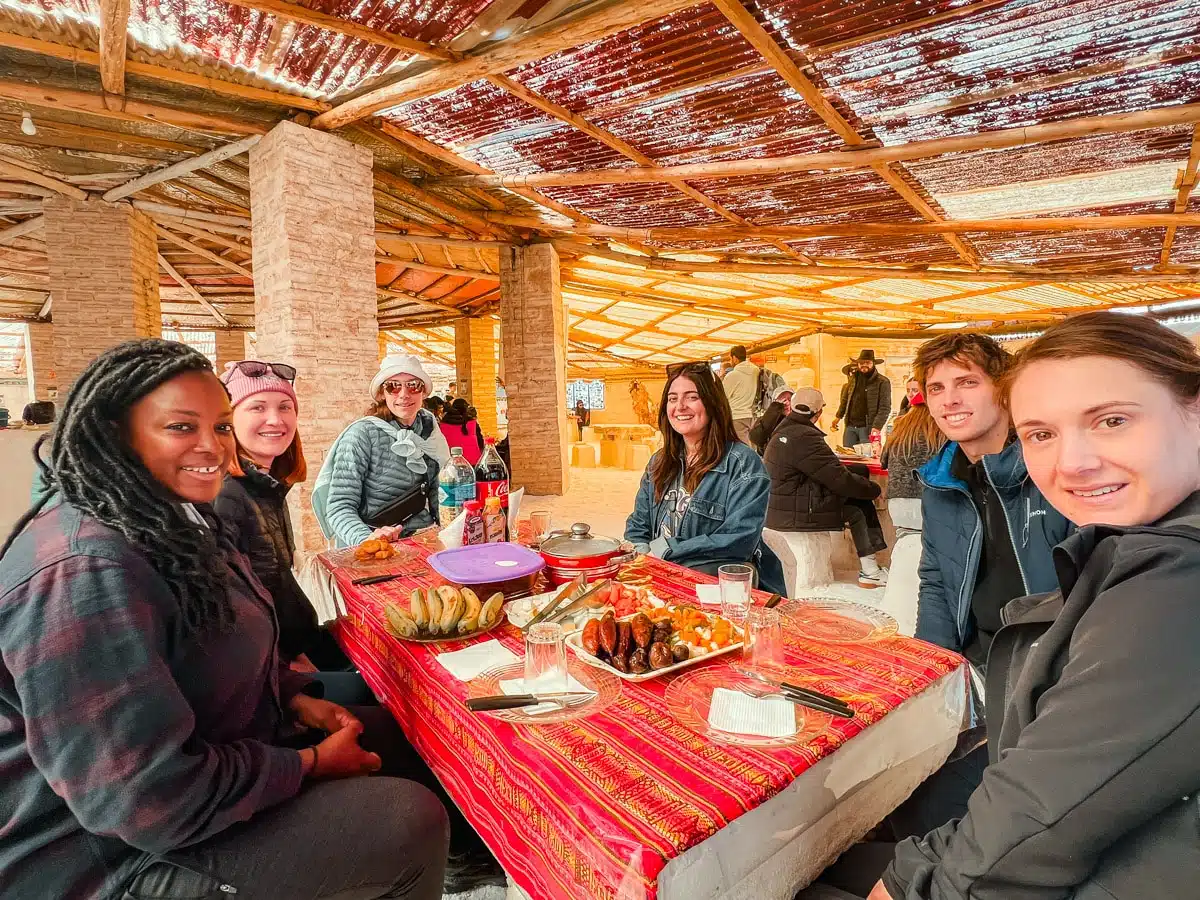
Frankly, taking a Bolivia salt flats tour is the best way to learn more about the destination, especially if you get a local guide.
You’ll need to be patient, as many of the tours aren’t quite as smooth as they should be. I recently took the Cordillera Traveller tour. While my guide was outstanding, the first day was a rough one, with no lunch and an aggressive driver.
What Are the Different Tours Available?
Here’s a brief overview of the most common Salar de Uyuni tours available. I’ve gone into more detail about each of them below.
- One-day salt flats tour from Uyuni
- Two-day salt flats tour from Uyuni
- Three-day Bolivian altiplano tours from Uyuni
- Four-day Bolivian altiplano tours from Tupiza (recommended)
- Four-day tours from San Pedro de Atacama
Why Do I Recommend the Tour from Tupiza?
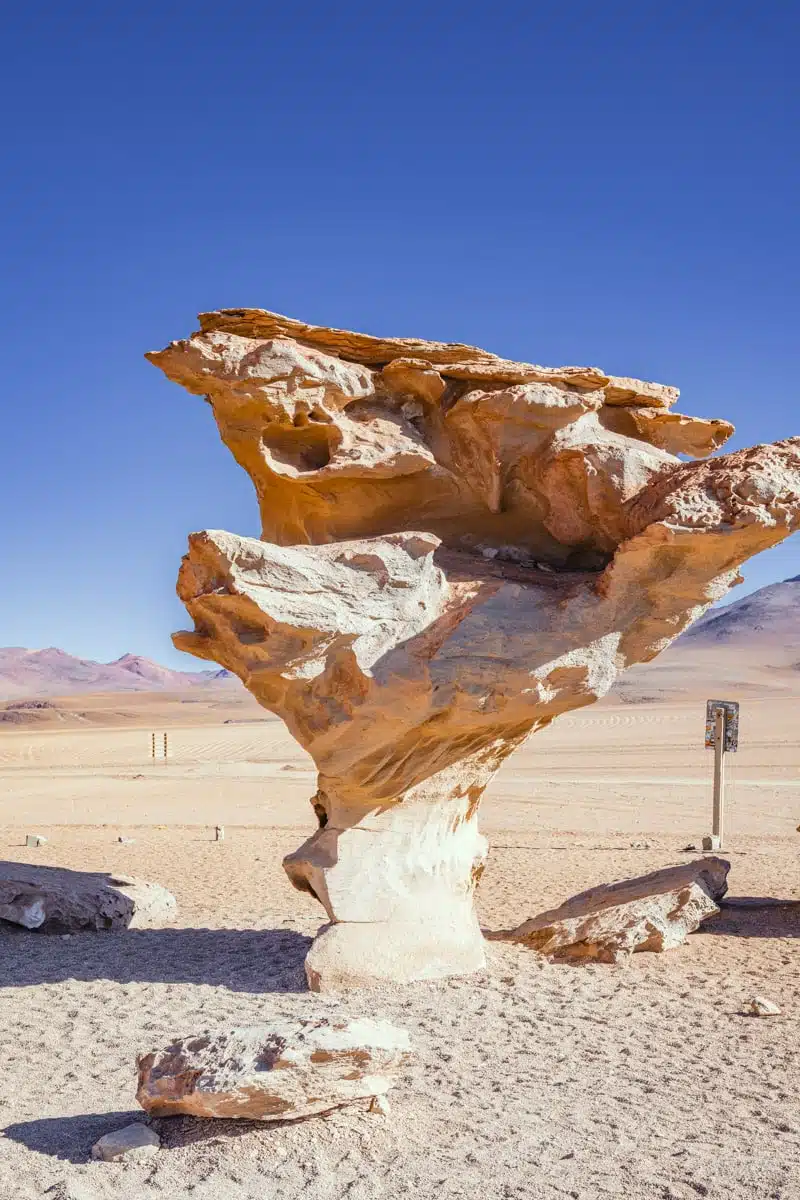
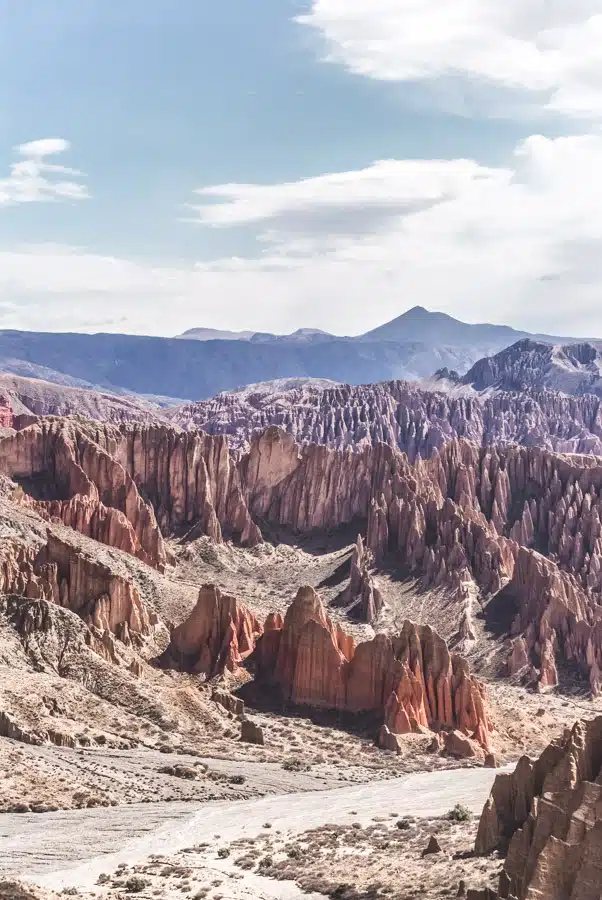
Although arranging a Bolivian salt flats tour is easily done from Uyuni itself, someone had tipped me off that the trip from Tupiza to Uyuni was much better. Why? Mainly because you get to see more of the area’s natural scenery and attractions.
So many people visiting the Bolivian salt flats do the same old tour. The landscapes are incredible enough that you’re pretty much guaranteed to be blown away whichever one you choose. But if there’s an option where you get to see more amazing stuff, quite frankly I don’t know why you wouldn’t choose it.
Sometimes a journey is as much of an experience as the destination and much as you’re in a hurry to see the Salar de Uyuni, it would be a shame to miss the other striking landscapes of the Bolivian altiplano.
Salar de Uyuni from Tupiza Tour Itinerary
Awesome sceneries abound in Bolivia. Perhaps none more so than on this Bolivian altiplano tour from Tupiza to Uyuni salt flats in the country’s wild west.
Here’s my trip report from the Tupiza to Uyuni salt flats tour I took to help you to understand what to expect.
Day 1
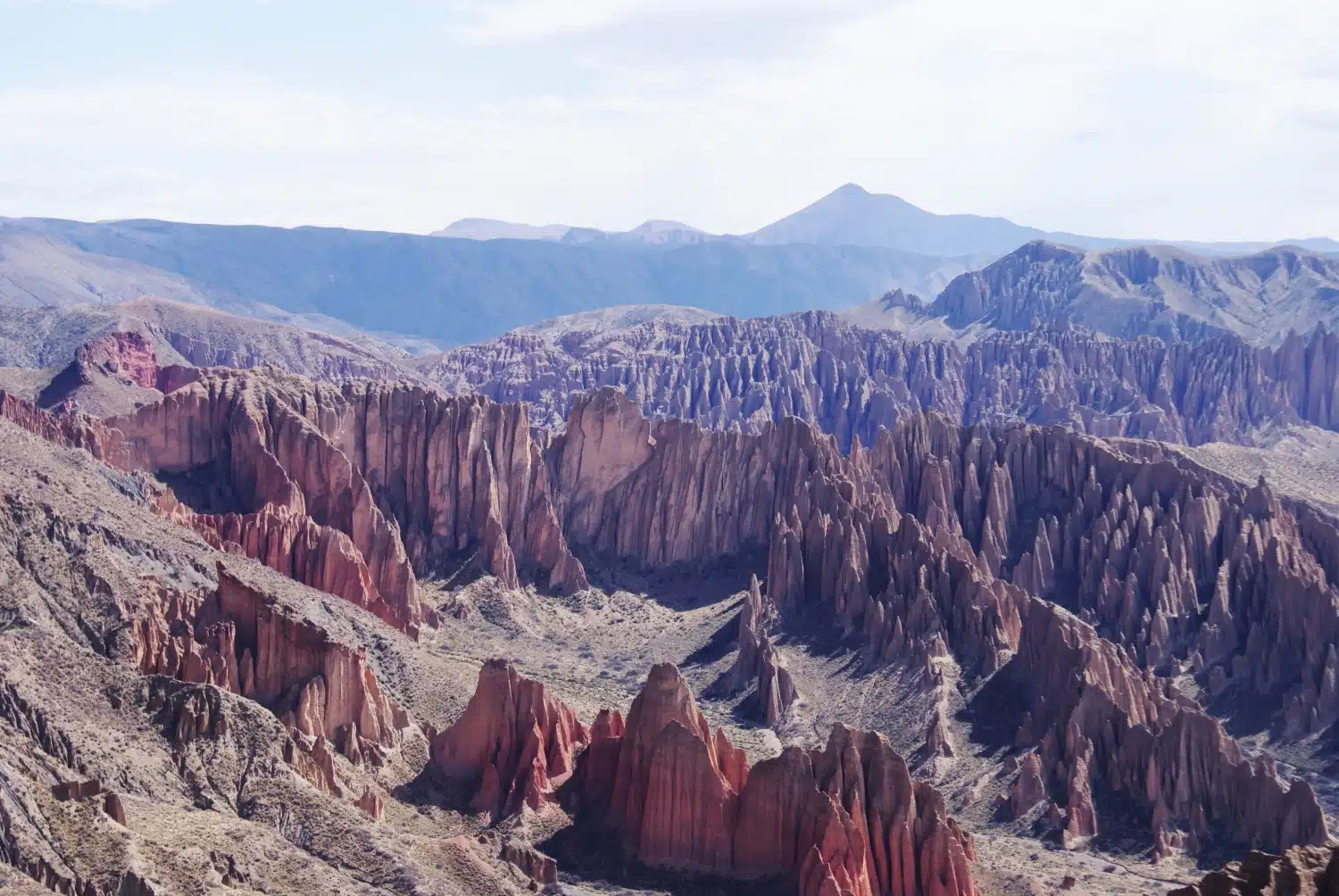
The adventure on our Tupiza to Uyuni tour began as soon as we left the town. Within a few minutes, we were climbing up a steep road with a sheer drop, and a stunning landscape on one side.
The first stop was at a wide gorge dotted with unnatural-looking precipices. Jagged triangular cliffs soared up at awkward angles below. “This is the Quebrada de Palala,” said our driver, Jose.
On the other side of the road lay an equally impressive valley, where the mountains and hills varied in hues from blue to bright orange. “The area is very rich in minerals,” he continued. “Each mineral makes the earth a different colour, which is why you have so many different colours in that valley.”
The rest of the day passed quickly: a maze of impressive landscapes as we gradually gained altitude.
Accommodation that night was basic, as were the nights to come but the meals were hearty and the beds comfortable – the best you’re going to find unless you pay a significant premium.
Day 2
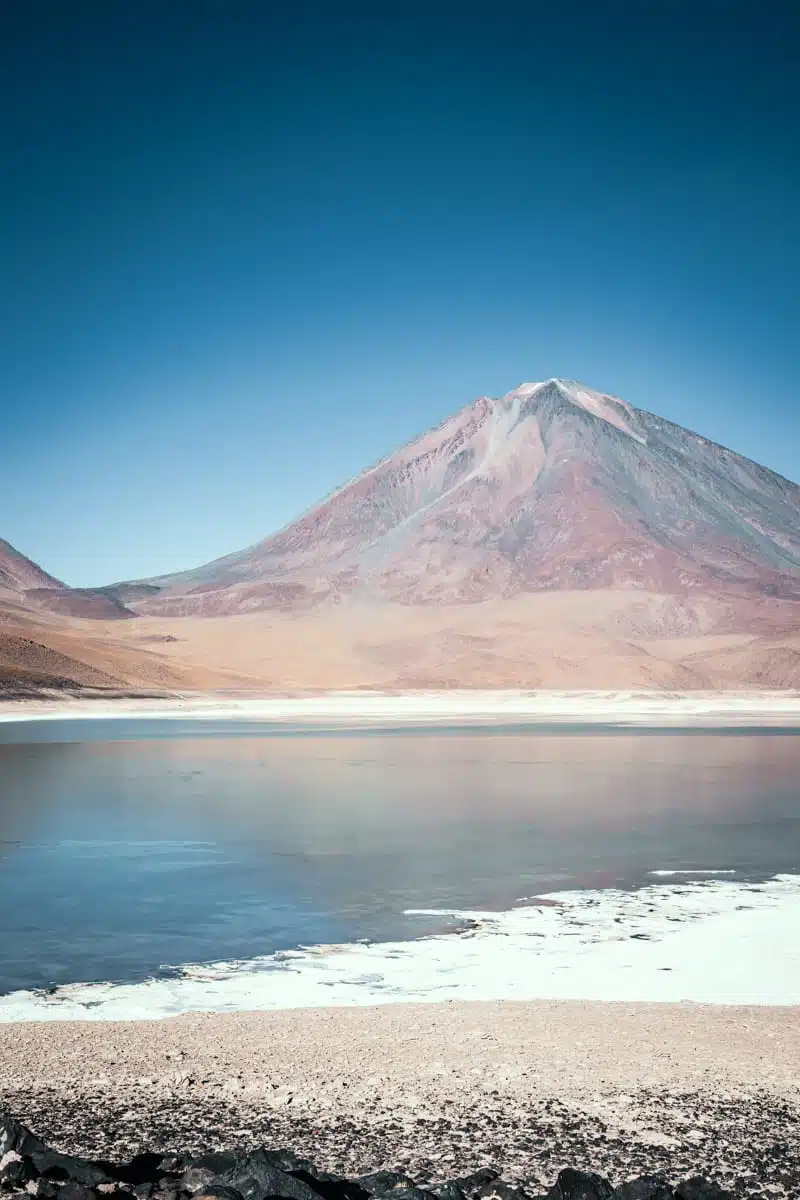
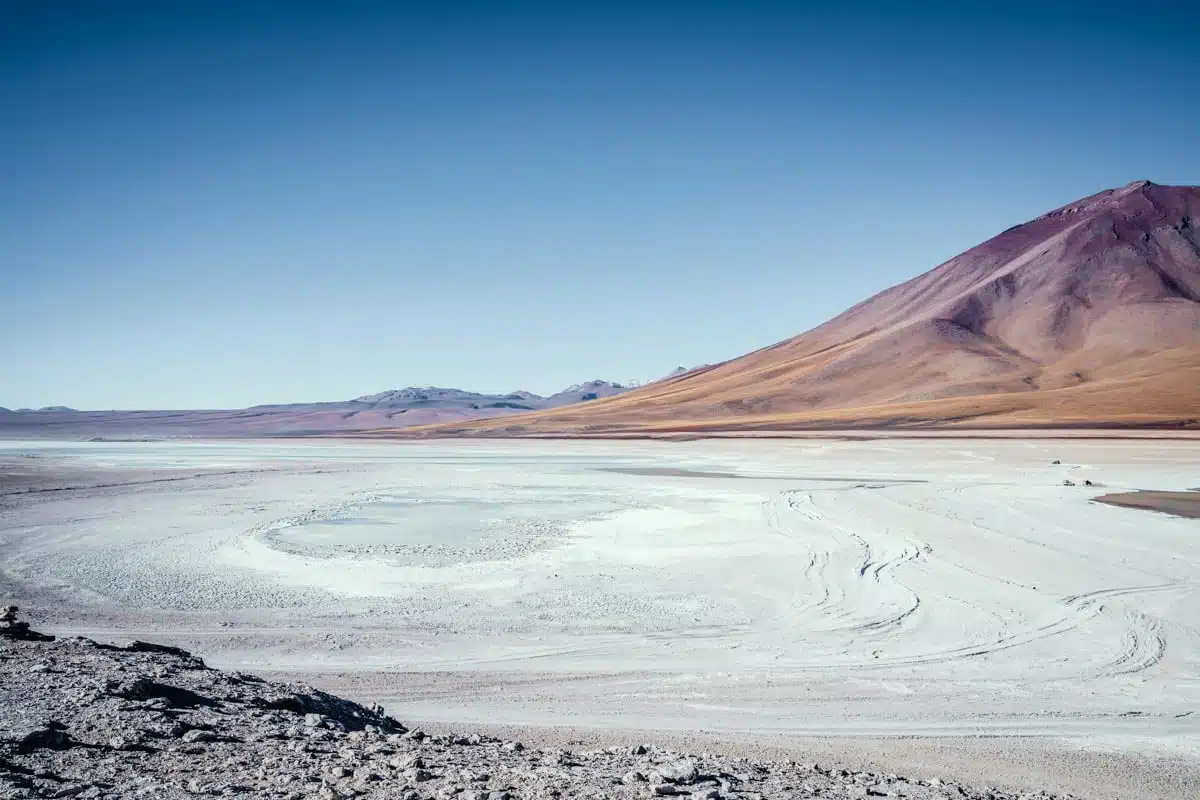
On the second day, we drove to the Laguna Verde, a green lake, and Laguna Blanca, a white lake, both of which were surrounded by a thick crust of salt, just a taste of what we were to see at the Salar de Uyuni on the final day of the Tupiza to Uyuni tour.
Driving along the roads, we saw locals warmly wrapped up in fleeces and clothes made out of precious llama wool.
As the day passed and we reached higher altitudes, the temperature continually dropped.
It wasn’t all about the jumpers, scarves and the elaborately patterned woolly hats favoured by locals and ‘gringos’ alike. We also pulled up at one of the much-welcomed highlights; the natural hot springs. Quickly donning our swimwear, we plunged into the pools and were welcomed by the warm water and a view of the adjoining lake.
Day 3
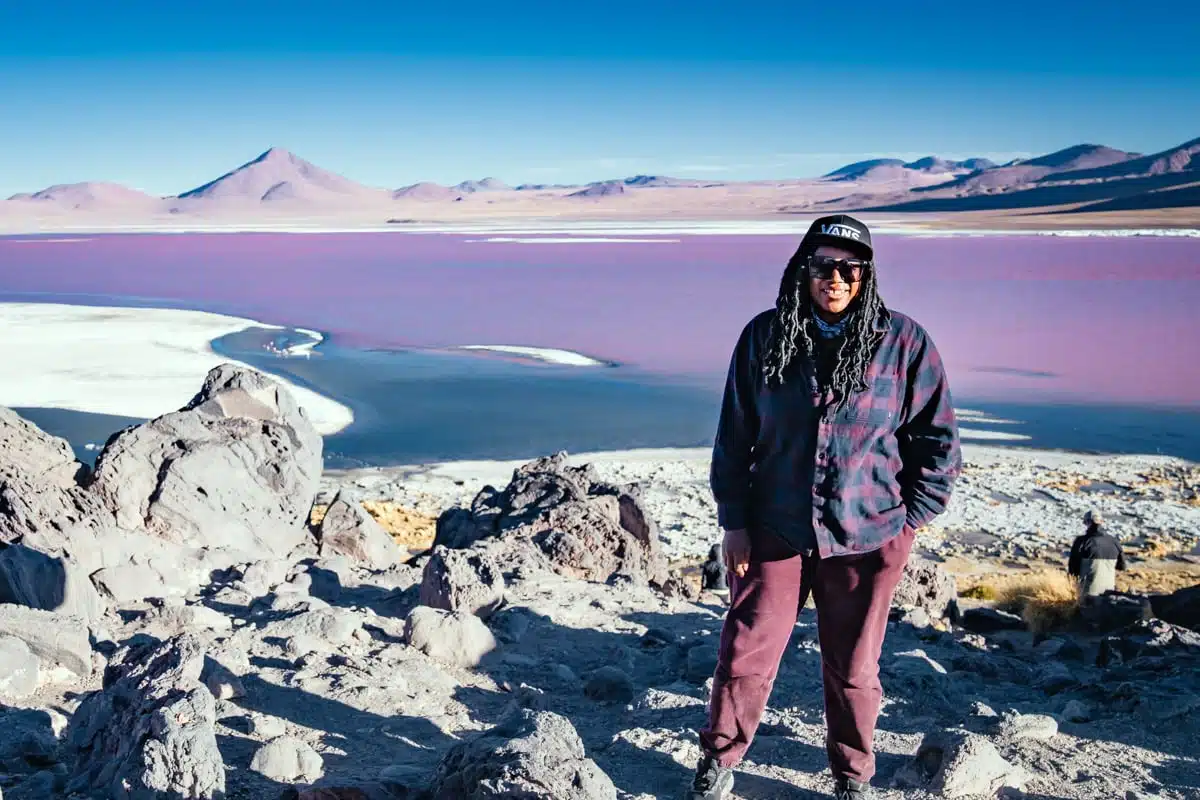
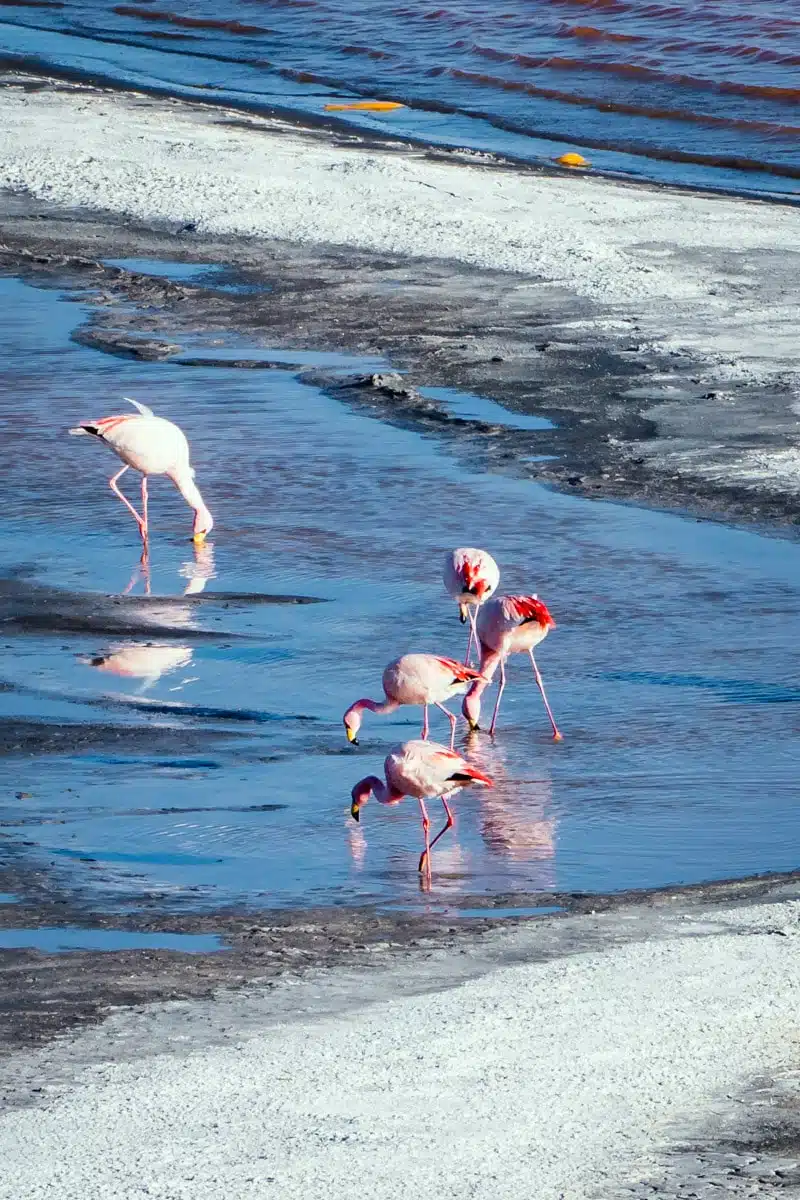
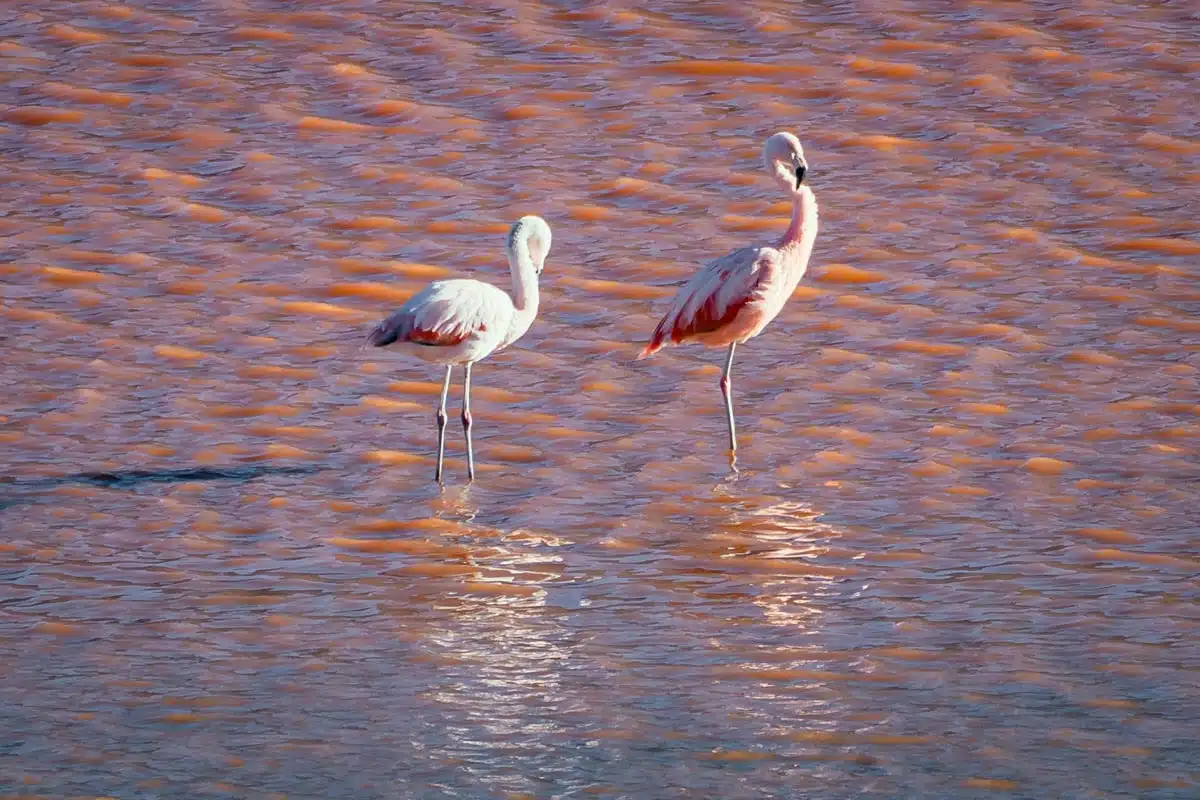
Minerals have played a major part in Bolivia’s history and present, but they are most immediately tangible in the landscapes.
On the third day of our Bolivian salt flats tour, we visited the Laguna Colorada, a lake of a bright red colour; caused by the high concentration of microorganisms in its waters. Dotted by thousands of pink flamingos, the effect is a rare one — the red of the lake and the pink of the birds stretching out for miles.
One of the beauties of the trip from Tupiza to Uyuni is the sheer variety of things to see. Bumping along the rather rough road, we’d turn a corner and be confronted by a desert plain dotted with weird rock formations, including the so-called stone tree, named for its tree-like appearance.
Peeping around another corner revealed a large lake bubbling with grey sulphuric mud springs. Salt plays such an important part in the landscape and could be seen almost everywhere.
We stopped in each place and took time to explore, climbing the rocks and running around to keep warm in the chilly wind.
Day 4
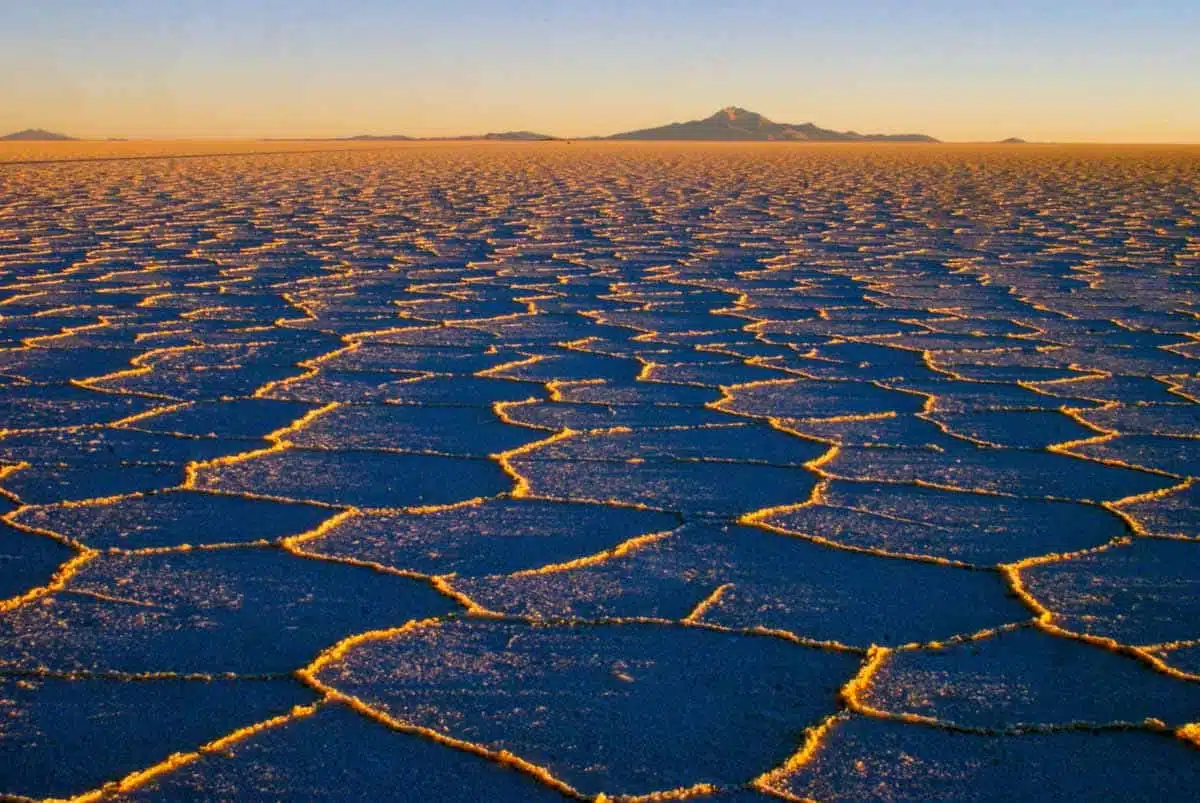
On the final day, there’s no doubt that we all grumbled as our 4am wake-up call sounded.
Piling into the Jeep, we peered anxiously for a glimpse of the Salar de Uyuni — the reason for the whole salt flat tour. As the sun began to rise, we realised that we were already driving along it!
I thought I had seen it all until I gazed out on the never-ending panorama of Uyuni’s salt flats. Miles and miles of thick salt crust crisscrossed with a jagged pattern of intersections. If you looked hard enough, you could see the faint tyre marks of the 4×4 that had brought us out to the middle of the plains.
Over the past four days, I had seen red lakes, green lakes, white lakes, jagged valleys, sulphuric springs, small Andean communities and llamas and alpacas galore. Still, nothing had prepared me for this.
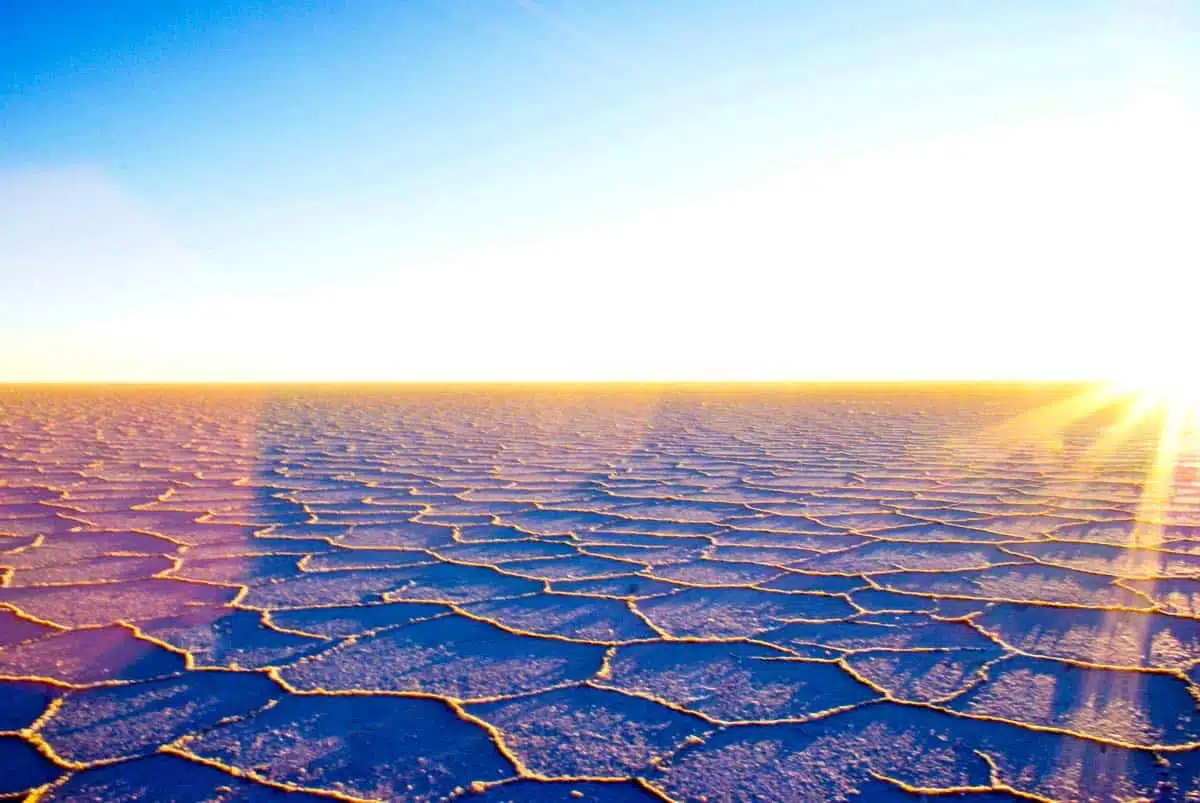
As the sun rose, the intersections between the interconnecting pieces of salt glowed orange. Gradually the light brightened, until our guide, Jose, warned us to put on our sunglasses to avoid snow blindness.
It was the perfect end to a four-day tour that had taken us from Tupiza to our final destination of the Salar de Uyuni.
We’d all faced the gruelling demands of the altitude (at the highest point in the trip, we reached 5,200 metres), along with which came the freezing nights that made you hurry for your sleeping bag as soon as the sun set.
We entertained ourselves for a few hours taking silly pictures and generally celebrating reaching our destination.
Finally, exhausted, we piled into the car and drove to the rather worn town of Uyuni, which was our final destination of the four days — many pictures and unforgettable memories later.
Alternative Tours
One-Day Tour from Uyuni
These usually start off with a visit to the train cemetery, then spend most of the day on the Salar de Uyuni with a trip to the “Fish Island” in the middle of the salt flats. Returns to Uyuni on the same day.
Three-Day Tour From Uyuni
Same first day as the one day tour. These tours head further into the Bolivian Altiplano so you see more on the tour. You visit deserts, the Laguna Colorada, Laguna Verde and Laguna Blanca and the crater of the Sol de Manana volcano.
Four-Day Tours from San Pedro de Atacama in Chile
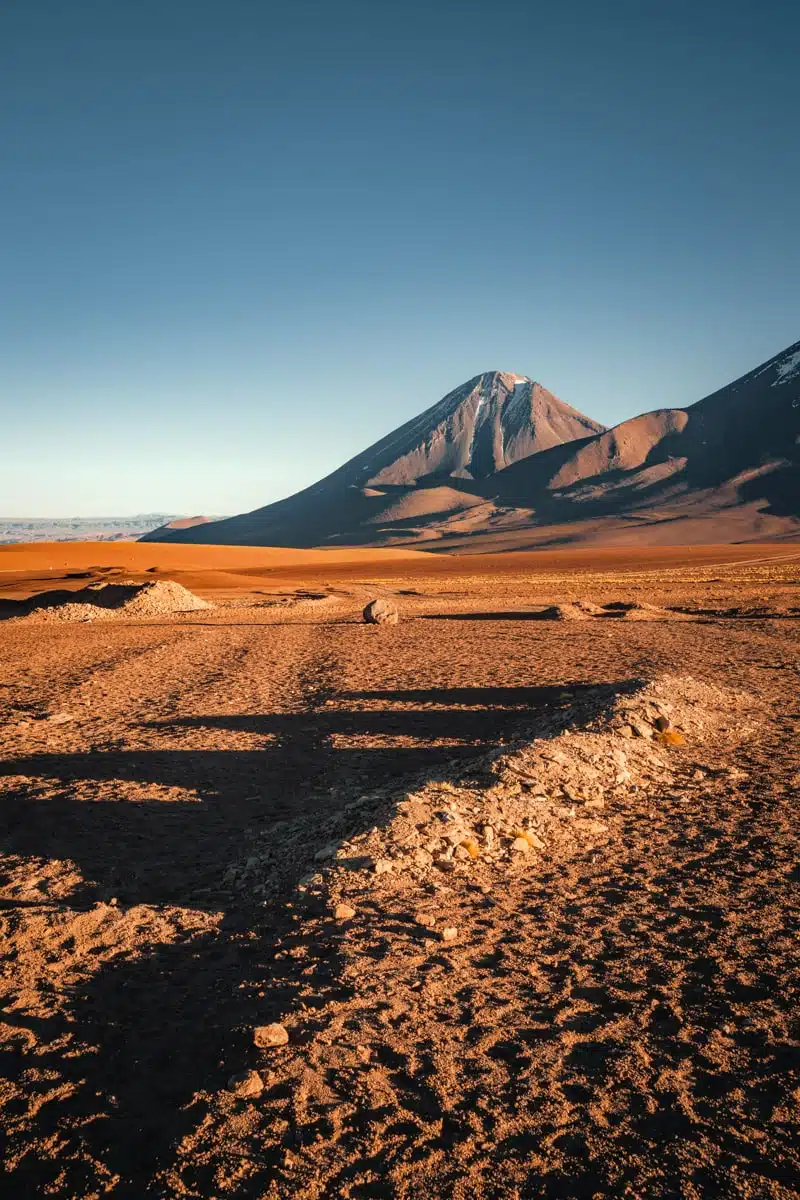
On day one this tour leaves San Pedro de Atacama and visits Licancabur volcano, Laguna Verde and Laguna Colorada plus the Polques hot springs and Sol de Manana. Day two covers a variety of lagoons for some flamingo spotting, cave paintings and a few canyons. The third day heads to the Salar de Uyuni itself and on the final day you return to San Pedro de Atacama.
Starting Your Tour
As I explained above, there are three main starting points for trips to the salt flats: Uyuni, Tupiza and San Pedro de Atacama in Chile. Here’s how you get to each one of them.
How to Get to Uyuni
By Bus
From La Paz you can get an overnight bus to Uyuni. It gets a bad rep but I did it in the other direction (from Uyuni to La Paz) and it wasn’t a big deal. The bus station in La Paz is a bit rough, just watch your bags as pickpockets are pretty rife.
The trip from La Paz to Uyuni takes about 7.5 hours. If you choose to take a bus, it will cost you about £16 to £23.50 ($20 to $30) each way.
By Train
You can take a train from Oruro to Uyuni. Oruro is about 3.5 hours by car from La Paz, so you’ll need to arrange transportation there first. The bus ride is relatively inexpensive, at around £4 ($5). From Oruro, the train ride takes around 7 hours, but it’s a beautiful ride and costs around 8 £ ($10).
By Air
Alternatively you can fly direct from La Paz to Uyuni. Getting from La Paz to Uyuni by plane takes around 1 hour and is typically around £157 ($200).
How to Get to Tupiza
Now, I’m not going to lie. Getting to Tupiza is a little more difficult than going direct to Uyuni, and generally involves an uncomfortable bus journey from one of the major cities.
The bus I took seemingly sought out potholes to bump over just for the sh*ts and thrills but it got me there and I came out in one piece so no stress. Just a bruised ass. Totally worth it though.
Fly to the Bolivian capital, La Paz, and catch a bus to Oruro and then a train to Tupiza.
Alternatively, fly to Salta in Argentina (via Buenos Aires), get a bus to the Bolivian Border at La Quiaca/ Villazon (six hours) and then catch a bus to Tupiza (three hours).
How to Get to San Pedro de Atacama
If you are getting to San Pedro de Atacama from Santiago, Chile’s capital, you are best flying to Calama airport and then either booking a transfer or catching a bus to San Pedro de Atacama.
How to Choose Your Tour Company?
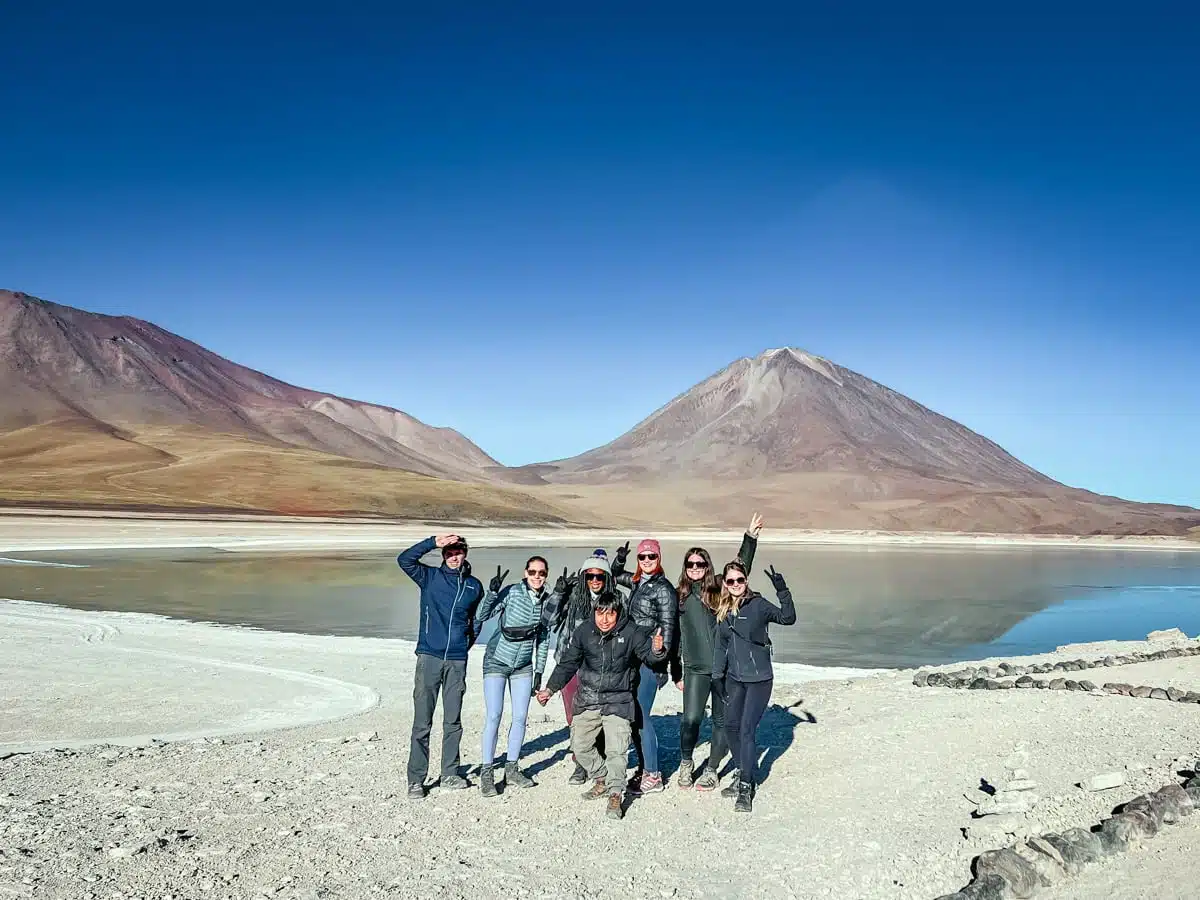
There are a lot of tour operators offering very similar tours to the Bolivia salt flats so it can be difficult to choose between them. Although it is tempting to go for the cheapest tour, it’s a decision that can come to bite you in the ass.
Spending the extra $ can make the difference between doing the tour in a vehicle that breaks down all the time with a guide who doesn’t speak your language and spending nights in super-basic accommodation and… not having to suffer any of those things. I exaggerate not.
As a guideline, you should find out:
- Does the driver speak your language? Many drivers do speak English but some don’t – make sure you check ahead.
- Will they pick you up from your accommodation?
- How many people are there per vehicle?
- How new are the vehicles?
- Where does the tour start and end?
- What food and drink is covered?
- Does the tour include entrance to the national park? Heads up: the answer to this is usually no.
Where to Stay for Salar de Uyuni
Hotel de Sal Luna Salada (Luxury)
Want to spend the night in a Bolivia salt flats hotel? Hotel de Sal Luna Salada is about as cool as it gets – as the hotel walls feature salt blocks from the nearby flats.
Located in Colchani in the heart of the salt flats, you can choose twin or full-size beds in this well-designed accommodation with views of the mountains and flats.
Enjoy local Andean cuisine at breakfast, fun activities in the game room, and a gorgeous viewing deck with fire pits for chilly evenings.
Casa del Sal (Mid-Range)
Another of the famous salt hotels in Uyuni, Casa del Sal, offers affordable rooms that feature brick-walled interiors with nature-themed decorations and exposed beams on the ceilings.
Rooms are plenty spacious and available at good rates, making it a good choice if you’re visiting on a budget.
What to Pack for Salar de Uyuni
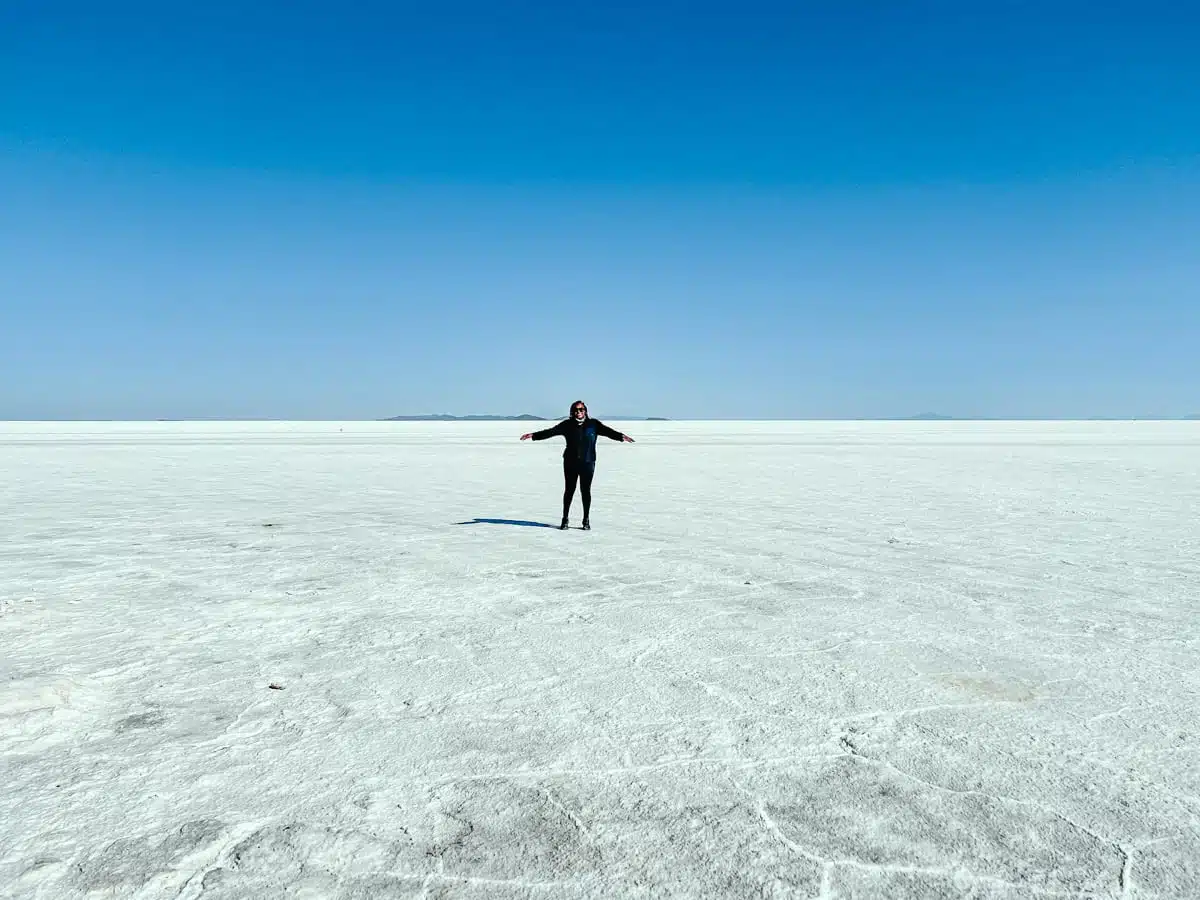
So, the altiplano is that difficult combination of having super-strong sun and very cold temperatures at night. Wrap up warm and wear layers you can easily remove as the temperature is incredibly changeable.
I suggest a thermal base layer top and bottom, a mid layer, a jumper and a softshell to help keep you snug against the wind.
Some things you’ll definitely want to pack include:
- Base Layer Top
- Base Layer Bottom
- Brushed Fleece Shirt
- Warm Bottoms
- Fleece Half-Zip
- Outer Shell
- Waterproof jacket (if you’re visiting in the rainy season)
- Water bottle
- Hiking trainers / Hiking Boots
- Sunglasses
- Sunscreen
- Hat
- Scarf / Buff
- Gloves
- Woolly socks
- Quick dry towel
- Swimwear
- Chapstick
- Head torch
Map
Read More Bolivia Travel Guides
- 10 Days in Bolivia, The Perfect itinerary
- The Best Bolivia Salt Flats Tours
- 18 Amazing Places to Visit in Bolivia
- Surreal Bolivian Landscapes that you Need to See to Believe
- When’s the Best Time to Visit the Bolivian Salt Flats?
Love This? Save and Share on Pinterest!
